Text
Let’s Rank the Samurai Rangers!

Power Rangers Samurai gets a bad rap among fans, probably deservedly so. I don’t watch Super Sentai, but people who do tell me that Samurai is basically a very lazy direct translation of Shinkenger. That may be true, but I actually kind of enjoyed it. Don’t get me wrong, it’s no RPM or Dino Thunder, but it’s also nowhere near as bad as Megaforce. Regardless of where you stand on the show, one of the most consistently-cited issues that people tend to have with the show is the characters (and, depending on who you talk to, maybe the cast too). Again, I tend to hedge on this, because I think most of the actors are fairly capable and do a fine job with what they’re given. That said, I will concede that some of the rangers just...suck. So let’s get to the rankings! From best to worst, here they are (oh, and I’m skipping Lauren):
1. Mike (the Green Ranger)

Mike (Hector David Jr.) is the best, and this is should be so self-evident that I shouldn’t even have to make a case for him. So I’ll limit my argument to this: in “Christmas Together, Friends Forever,” Mike, who loves Christmas more than anything else which automatically makes him the best, gives his only present--a brand new dirtbike--to Bulk and Spike on Christmas, because they have nothing.
2. Mia (the Pink Ranger)
I hesitated whether to place Mia in this spot or the next, but ultimately she gets the nod at second, because I am only a man.

Yes, I may be 31 years old, am happily married, will soon be a father, own my own business, and have a mortgage, but every time Mia (Erika Fong) steps onscreen, I swoon like a 13-year-old girl (I may or may not have even said, “You’re so pretty” out loud).
Like everything else about this show, her gimmick of loving to cook despite being godawful at it is polarizing, but I think it’s kind of cute, and it also adds a nice touch of brevity in contrast with Jayden and Kevin’s seriousness. She does need further development, but that goes for every else in this series, and like I already said, she’s really pretty.
3. Emily (the Yellow Ranger)

I’m glad that when Saban bought back the rights to Power Rangers from Disney that they decided to carry on the Disney tradition of casting super-cute, perky blondes (Tori, Kira, Syd, Claire, Ronnie, Lily, Summer)...usually as the Yellow Ranger.*
Emily has the potential to be even better, but what we did get is pretty good. She’s fun, kind of clumsy, and occasionally she and Mike make eyes at each other. Yes, they should have done something more with her being chosen to be a Ranger instead of her sister, and her and Mike’s romance could have been developed more (basically they go from sort of flirting to being a couple in the final episode with no in between). That said, when Emily finally gets a chance to go nuts in “Strange Case of the Munchies,” actress Brittany Anne Pirtle grabs onto every scene and takes it for all its worth.
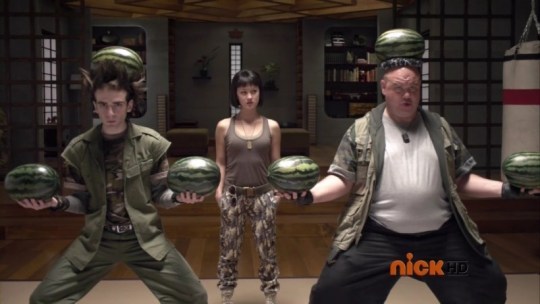
In my own head-canon, I also like to imagine that this episode partly inspired “Dark Betty” in Riverdale.
4. Jayden (the Red Ranger)

Placing Jayden in any place other than last might be controversial for many fans, since he often bears the brunt of their wraith, but I tend to disagree.
Yes, his brooding lone wolf character probably worked better for his Super Sentai counterpart, given the abundance of these types of characters in Japanese culture (I get Squall from Final Fantasy VIII vibes from him). That said, he does get a lot of backstory that helps establish why he is the way he is, and when you consider that he’s been burdened with the task of destroying Master Xandred since he was a child, you can see why he see’s a bit messed up. It’s not perfect and the execution is sometimes lacking, but there are good ideas there.
Additionally, Alex Heartman actually does have charisma and, on the occasions when he’s given good material, he does a good job with it. Plus, even at his worst, there are two rangers that are much worse than him.
5. Antonio (the Gold Ranger)

There’s things about Antonio that work really well: the fact that he’s a self-trained Samurai Ranger who isn’t descended from a long line of Samurais’, which gives him both a different perspective and approach towards being a ranger, his relationship (bromance? romance? whatever floats your boat) and history with Jayden, and his general light-hearted attitude. The problem is that as good as all those things are, it’s hard to overlook just how grating his character can be.
I don’t mind goofy characters; Ivan and Koda are two of my favorite Power Rangers ever, and I’ve also loved Bridge, Gem and Gemma, Dustin, and Ziggy, among many others. I’ve never understood why some fans get up in arms about these types of characters. Like, you do realize that you’re watching a show made for 5-8 year olds? However, when we’re presented with characters like Antonio (and, even worse, Dax from Operation Overdrive), I can start to sympathize with this mentality.
The problem with Antonio is that actor Steven Skylar spends far too much time mugging to the camera. Everything about the performance is way too over-the-top, including the random Spanish interjections. I suspect that since Skylar is actually of Thai descent, the producers felt the need to have him beat the audience over the head with “Fantastico!” I generally try not to blame actors, especially because it’s entirely possible that they were directed to act in a specific way, but I also can’t help but wonder if I wouldn’t have liked Antonio more if he had been played by another actor.
Still, he’s not the worst. There is someone much more deserving of that:
6. Kevin (the Blue Ranger)
God, Kevin, you suck so much. No, seriously, Kevin, you’re the worst.

(This GIF is priceless, but I also kind of wish that Mike just wrapped his arm around Kevin and strangled him right then and there)
Okay, so if you’ve watched more than one season of Power Rangers, you’re probably seen similar characters. Given that the creators essentially have to come up with a brand-new cast every year for 25 years, it makes sense that they would rely on archetypes. Kevin follows of the mold of the stick-up-their-ass, by-the-books second-in-command much like Kai, Jen, and Sky before him.
There are a few problems from the beginning; for one, those three were all partnered with more laid-back Red Rangers (Leo, Wes, and Jack), and so they served as nice foils, constantly second-guessing the leader. Over time, these characters would gradually see that, although the Red Rangers didn’t following standard operating procedure, they were effective leaders in their own way, and they would come to respect them. It’s a good dynamic, and you can understand why they’ve returned to that well multiple times.

(That “What the fuck”-look that Mia gives Kevin is exactly how we all feel)
With Kevin, they tried something different (which is good, I guess) and had a serious second-in-command who idolizes his equally intense leader. So instead of forcing them to see (and come to respect) a different point of view, this dynamic just reinforces their own stupid biases. Worse yet, unlike, say Erin Cahill (Jen) or Chris Violette (Sky) who were still likable characters even when their heads were up their asses, Najee De-Tiege has no charisma or charm, and it’s impossible to like Kevin.
If you want a quick introduction to why Kevin is the worst, look no further than “The Blue and the Gold.” So two episodes after joining the team, Kevin still hasn’t accepted that Antonio is part of the team. Antonio tells that he made a new Zord, and Kevin’s like, “You made it from Electronic Symbol Power? I don’t accept that!”
Hey, asshole, how many fucking Zords have you made?
“.....”
None? That’s what I thought. So shut the fuck up!
The other rangers tell Antonio that Kevin won’t accept him unless he can adapt to his training habits. So Antonio follows him around observing his daily routine (i.e. non-stop training) and tries to copy him the next day. Kevin catches him and says, “Despite the fact that you’re gone through all this effort to try to copy me, I don’t think you’re taking this seriously so fuck off!” Before Antonio can tell him to take his head out of his ass, they’re attacked and can’t communicate with the other rangers. It’s not a problem though, because they’ll know something is wrong when Kevin is late. This is when we find out that Kevin has a daily routine that goes down to the minute. As much as I despise Kevin, this is so hilariously awful that I can’t help but love it.
Later they’re attacked again, and Antonio hurts his arm, but he sticks around and defeats the bad guys anyway, and Kevin goes, “Wow! You really are dedicated. I finally respect you,” despite the fact that Antonio has been doing this for the past two episodes. Kevin must be one of those people who says, “Yes, the Golden State Warriors have made three straight NBA Finals appearances, won the championship twice, have multiple All-Stars, and a two-time MVP, but I just don’t think they’re very good.” Then if Golden State wins this year, he’s finally like, “Oh, I get why people think they’re good.”
Welcome to the fucking party, dipshit!

*-After this, they’d do it again with Gia (Ciara Hanna) in Megaforce.
#Power Rangers#power rangers samurai#power rangers super samurai#jayden shiba#mia watanabe#antonio garcia#alex heartman#erika fong#brittany pirtle#hector david jr#najee de tiege#steven skylar
14 notes
·
View notes
Text
Some Thoughts about Power Rangers Jungle Fury
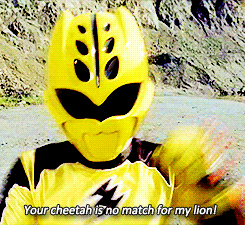
Blame it on Boom Studios.
So, like every child of the ‘90’s, I loved the Power Rangers growing up. Before Nickelodeon and Cartoon Network existed, I would religiously tune into Fox Kids every Saturday morning so I could watch X-Men: The Animated Series and Mighty Morphin Power Rangers. While I remained an X-Men fan for life, I stopped following Power Rangers sometime after the movie. That was all well and good, but then Boom Studios had to go and launch a MMPR ongoing that ended being really good. That fired up the nostalgia machine, and the next thing I knew I was rewatching episodes of Mighty Morphin.
I didn’t rewatch the entirety of the series, because it’s over 150 episodes, and, I mean, I got shit to do, but on an impulse, I started watching the most recent series, Power Rangers Dino Charge, which was so good that I watched the whole thing. Now I’m interested in watching other iterations, so arrived at Jungle Fury through the incredibly scientific process of liking the name of the title and the concept of “Kung Fu Power Rangers.” Anyway, here’s some thoughts:
The Good:
The Characters: because I was raised on the one-note characters of MMPR, my expectations in this area are quite low, so I was pleasantly surprised by the cast of Jungle Fury. Not only is each of the principals well-defined, but they, especially Casey, also experience genuine growth over the course of the series. Further, every Ranger is likeable and easy to connect with. Granted, some fans find RJ annoying (otherwise known as people who hate fun), but he’s actually the best character in the show. Not only is David de Lautour the strongest actor in the cast (check out his interactions with his father in “One Master Too Many”), but the character is quite clever in the way that it plays with the audience’s expectations for a Kung Fu master and then turns it on its head (something that the show even jokes about when Casey, RJ, and Lily assume that the older Asian man is their new master in the first episode). The villains are also nicely developed with the primary antagonist undergoing a genuine arc. Jarrod’s “bad guy tempted to be good” is another clever inversion on a traditional storytelling trope. Even Camille, the villain’s sidekick, gets a kind of arc and development, owing to her love for Jarrod.
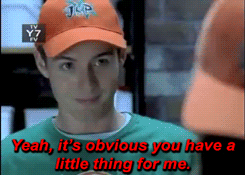
The Plot (mostly): One of the best parts of Jungle Fury was in the way that the series really committed to its theme of Kung Fu. Many series have themes, but only make half-hearted use of them and end up pretty much just Power Rangers business as usual; however, Jungle Fury incorporated a lot tropes from kung fu and used them quite effectively for the story. For example, each of the rangers studies with a mentor to help them become more powerful (even better, these lessons also saw the Rangers develop further as characters, which, again, harkens back to the great characterization in this series). In a clever twist, the primary villain mirrors the Rangers’ development by training and studying under evil mentors himself. Further, this makes the overall overarching story feel like it’s building towards something grand and epic, rather than a series of monster-of-the-week episodes.
The Fights: Again, the show really demonstrates how committed it is to its theme, incorporating the kung fu aspects into the fight choreography as well. I’ll admit that I tend to zone out a bit during the Zord sequences, but Jungle Fury kept me considerably more engaged than some of the other series that I’ve watched.
The Rinshi God, I love the Rinshi so much and their double-footed hop.
The Bad:
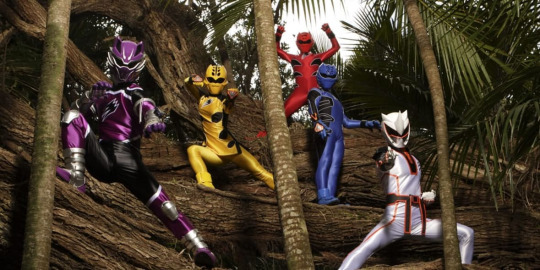
The Costumes: Personally, I don’t hate them as much as some, but they’re definitely in the bottom half of the franchise as a whole. The original suits aren’t bad, but, for whatever reason, the white neck really bothers me. The Jungle Master suits are also a definite upgrade on the base suits; however, the Purple and White Ranger costumes are just godawful.
The Monsters: Here’s my incredibly basic criteria for good Power Rangers monsters: do I remember them when the episode is over? Now, obviously, I can’t name every monster from a season that I like, but I can picture several different monsters from both MMPR and Dino Charge (I smile a bit when I think about the one created by Swatt and Baboo out of a bunch of random sports equipment and a stoplight). When judged on those criteria, Jungle Fury falls short. Outside of Carnisoar, Jellica, and Grizzaka (and, of course, the incredible Rinshi), I can't recall a single monster. That's....not good.
The Finale: Remember how I raved about how great the plot was a couple of paragraphs ago? Yeah, a lot of that was undone by an anticlimactic final. So the entire series is basically one giant build, with the Rangers getting progressively stronger and gaining new powers and techniques while Jarrod simultaneously powered up. Then the Rangers manage to separate Jarrod from Dai Shi, convert Jarrod and Camille to their side, bring back the Spirit Rangers, and gather everyone together, but all they need to do to defeat Dai Shi’s dragon form is chant a few things. Jungle Fury doesn’t seem to get a lot of love from fans (although, for that matter, it doesn’t seem to get a lot of hate either), and I think the final episode is a big reason why people aren’t more passionate about the series.
…And the Accents?
Ever since Disney purchased the franchise, filming has taken place in New Zealand, meaning that the cast of each series is typically made up of Australians and Kiwis’. In fact, not a single American is in the main cast of Jungle Fury. Here’s my arbitrarily-assigned score for each character:
Casey (Jason Smith)–8.5/10: I actually thought Smith was Canadian until I looked him up on IMDB and found he’s actually Australian. His accent is pretty good, but the giveaway is how unnatural his voice sounds when he’s shouting his dialogue after transforming.
Theo (Aljin Abella)–7/10: Theo is another one who I was a bit surprised by; his voice sometimes comes across as stiff, which I initially assumed was a deliberate acting choice rather than because he was hiding an Australian accent.
Lily (Anna Hutchison)–5/10: Anna Hutchison loses points for inconsistency; more than half the time, but when it slips, it really slips.
RJ (David de Lautour)–8/10: RJ might be the best of the bunch, but I also feel that David de Lautour had an easier job since he merely had to imitate a very specific accent–the stereotypical surfer–rather than a more general American accent like the others.
Dom (Nikolai Nikolaeff)–7/10: This is unrelated, but it was really hard for me to get over seeing one of the Russian mobsters from Daredevil playing the White Ranger.
Fran (Sarah Thomson)–8/10
Camille (Holly Shanahan)–7/10
Jarrod/Dai Shi (Bede Skinner)–3/10: At least he tried?
Power Rangers Power Rankings
Dino Charge
Jungle Fury
MMPR
7 notes
·
View notes
Text
Valiant Roundup
The roundups aren’t finished yet! (Seriously, the roundups may never finish) I still have a lot of comics that I’ve read and am trying to clear–11 that I’ve already read, plus another 3 that I’m in the middle of reading, and another god-knows-how-many that I have sitting in both my literal and digital stacks–and these types of posts feel like a more efficient way of getting through them. That said, I don’t think they’re that much shorter, because instead of writing 800-1,000 words on each comic, I’m doing something more like 700….but, whatever, I feel more productive. Anyway, here’s some overdue thoughts on some Valiant trades:

A&A: The Adventures of Archer and Armstrong vol. 1: In the Bag
A&A is the second time that we’ve seen Valiant relaunch one of its 4 original titles.* Unlike Bloodshot Reborn, which was relaunched specifically to continue the character’s narrative from The Valiant, The Adventures of Archer and Armstrong did not begin with a clear-cut direction or mission, rather there was a long enough break from Fred Van Lente’s run that fans were clamoring for the characters to come back, and so Valiant opted to bring them back.
Writer Rafer Roberts is relatively new to the comics industry, but he's worked for the publisher before, contributing a few pages of art for the various #25 issues (Archer & Armstrong, Bloodshot, Harbinger, Unity, and X-O Manowar), so it’s exciting to see him given an extended and higher-profile opportunity at Valiant both as the writer of this title and the new Harbinger Renegade. Unfortunately, he has large shoes to fill as Fred Van Lente’s run was a masterclass in humor, plotting, and world-building, and while he manages to keep the same tone, there’s a stark difference in quality between In the Bag and the Archer & Armstrong issues that preceded it.
Whereas Van Lente’s stories were heavily researched and involved complex ideas, this first arc is relatively straightforward: Armstrong goes into his magic bag to find something that he’s lost but is trapped by an old adversary imprisoned with, and so Archer (with the help of Mary Maria) must save him. The plot is actually manga-ish (a connection made even more apparent by David LaFuente’s artwork), and it’s perfectly fine, however, it lacks a lot of the emotional weight of previous Archer & Armstrong stories. Further, while I did get a few chuckles from the story–I laughed out loud when Baccus goes to the frat house–the humor was more “miss” than “hit” for me. That said, comedy is incredibly subjective and there are probably readers who would argue that Rafer Robert’s take is much funnier than Van Lente’s. Regardless, this first volume is fairly average, but I do think that it has a great deal of potential, so I’ll probably stick with it for at least another volume or two.
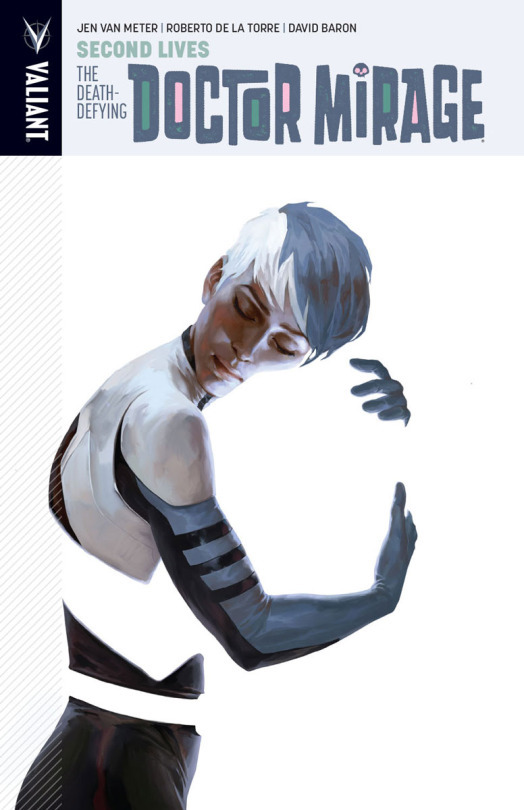
The Death-Defying Doctor Mirage vol. 2: Second Lives
Maybe this is a function of writing a review for every comic that I read, but when I don’t like something that I expected to enjoy, I often begin to second-guess my own opinions. Like, for example, is the book really not that great or is it just me? This is especially true for anything involving magic and/or the supernatural as I’m not inclined to that genre to begin with. With the first Doctor Mirage mini-series, I chalked my dislike up to my own disinterest in the genre, because there was genuinely strong writing, particularly in terms of characterizations and the interactions between the cast; however, with Second Lives it really feels like the problem is with the comic and not with me.
There are some noteworthy aspects of Volume 2. The characterizations, particularly in the interactions between the titular heroine and her husband, remain as strong as ever. The problem faced by Hwen and Shan–his ghost has remained, but they cannot have any physical interactions–is tragic and creates a strong emotional foundation that the story is built on. Further, introducing other “magical” characters who exist in the same realm as the Mirages makes the world of the comic more lived-in and complex. That said, the villain and most of the elements relating to him are dull and cliche. To her credit, Van Meter does use “magic” in a much more intelligent way than others in the genre have, which is to say that she actually attempts to establish some kind of rules rather than having it simply do what the plot needs it to do (or worse, ending with a light battle ala the second volume of Shadowman); however, at the end of the day, the comic still ends with a magic ritual that solves everything. There are certain limitations with this genre, but, regardless, The Death-Defying Doctor Mirage is lacking quite a bit story-wise, and even the strong parts of the comic aren't enough to recommend it.

Faith vol. 1: Hollywood and Vine
Although I’d argue that Valiant has done a fairly strong job of diversifying their line-up despite only publishing nine comics a month, Faith is very obviously the publisher’s attempt to cater towards a very different demographic. Not only was the title initially announced in Entertainment Weekly and stars a full-bodied, female lead, but the tone is far more light-hearted and whimsical than any other Valiant comic (even comedies like Archer & Armstrong and Quantum and Woody). Really, it’s highly reminiscent of Ms. Marvel and “hipster Batgirl,” and given how successful those titles have been in expanding past the traditional comics’ demographics, it makes sense for Valiant to pursue that same target.
As the title implies, Faith is now living in Hollywood, working at a Buzzfeed-esque website, balancing her superhero/alter-ego life, and fighting crime. There’s also mystery/conspiracy involving the Vine plantings (who had apparently become the go-to villains for Valiant comics published around this time), but the tone remains pretty light throughout. If you’re the kind of reader who likes a lot of the lighter Marvel titles like Ms. Marvel, The Unbeatable Squirrel-Girl, and Patsy Walker A.K.A. Hellcat, then you’ll absolutely love this. Personally, as a soon-to-be 30-year-old male, Faith isn’t necessarily my thing. I do like these kinds of comics, but in limited quantities, and so while Hollywood and Vine is pretty good, I’m not necessarily interested in continuing onto the second volume. That said, I couldn’t be happier that Valiant is publishing this title, even if it isn’t geared towards me, because it will have a lot of appeal for an entirely new set of readers.

Imperium vol. 3: The Vine Imperative
Personally, the joy in a title like Imperium that very deliberately creates an incredibly complex world is when the writer allows the story to meander so that the reader can further immerse themselves in that world. As such, The Vine Imperative is something that I loved–it might even be my favorite volume of Imperium–but I would also be completely unsurprised if others hate it. Essentially, Joshua Dysart takes all of the complex political tensions that have been brewing over the first two volumes and shelves them for the time being to tell a side-story about Toyo Harada and the Vine plantings.
The first issue does actually do a lot to advance the Imperium narrative, but we are quickly shown the reaction to these events through the eyes of the Vine planting, rather than PRS or the UN, which immediately gives you an idea of where the story is going. As it happens, Harada has history with the Vine dating back to the time of the first Harbinger Wars when he began experimenting upon them and, in turn, they made an unsuccessful assassination attempt on his life. Although the two sides established a kind of truce, his recent growing power has made them understandably nervous, and they decide to intervene.
I really liked the way that Dysart has essentially added even more depth to the already complex political tensions of Imperium with this volume. One of the frequent complaints was that despite the massive upheaval the events of the title brought the Valiant Universe, it was more or less ignored by the other traditions. While that remains true, The Vine Imperative does address that somewhat by at least demonstrating that a group who heretofore had really only been seen in X-O Manowar into the plot of this comic. It’s the kind of detail that makes the VU feel much more “realistic” (for whatever that’s worth) than the DCU or the MU.
Adding to my own enjoyment is CAFU’s artwork. He’s done quite a bit of work for Valiant in the past, and while his work is less stylized than, say, Clayton Crain’s or Raul Allen’s, it’s always clean and very clearly tells the story. Obviously, it’s not a good place to jump onboard, but Volume 3 is a true reward for anyone who has been onboard the title since the beginning.

Imperium vol. 4: Stormbreak
Uhmmm….okay?
Technically, this is the final volume of Imperium, but the story is in no way even close to being resolved. If you can find a way to ignore all of the external factors and focus just on the story itself, then Stormbreak is another strong installment in the series; however, as the end of the title as a whole, it can’t help but disappoint. To be fair to writer Joshua Dysart, it seems like Valiant’s decision to cancel Imperium was a rather abrupt decision, and Dysart simply didn’t have enough space to end his sprawling story (and based on the plot of Volume 4, he didn’t bother trying to resolve it either). That said, he mentioned on a Reddit AMA that there would a more proper ending (my guess? A Harbinger: Omegas/Shadowman: End Times-esque mini-series).
Anyway, there’s a lot that I really like in Stormbreak, which sees Livewire teaming up with the original H.A.R.D. Corps to expose Harada’s true actions (he’s funneling his remaining resources towards his space elevator at the expense of feeding the residents of the Foundation Zone). Any story that sees Major Palmer throwing down with Gravedog is enough to win me over, but Dysart adds some emotional depth with the detail that Palmer personally selected and trained Gravedog, only for the latter to betray PRS and the H.A.R.D. Corps. At the center of the story, however, is the very complex relationship between Livewire and Harada. We haven’t seen much of this relationship since Unity, but there is a certain amount of closure in seeing it on center display (and drawn by original Harbinger artist Khari Evans!). This is a good comic, but all the weirdness surrounding it just makes it feel incomplete.
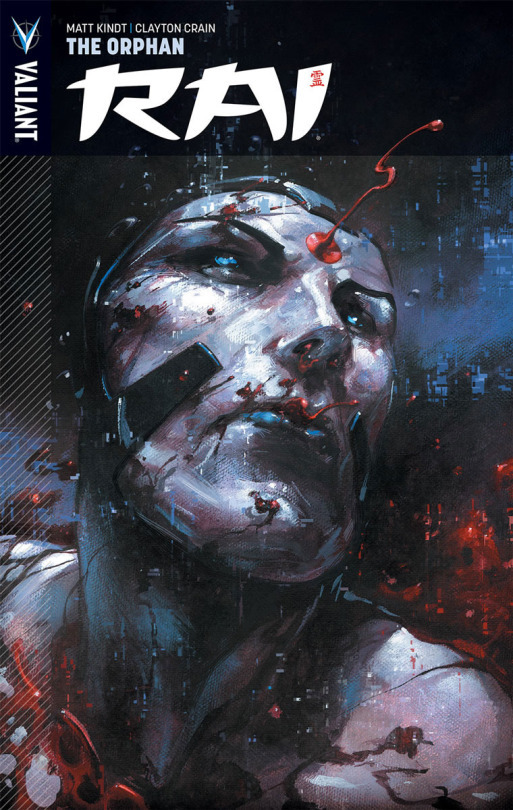
Rai vol. 3: Orphan
The third volume of Rai is clearly a transition arc between Volume 2 and 4001 A.D., but a lot of credit should be given to writer Matt Kindt for not remaining content to simply let the story spin its wheels. Instead, quite a bit of exposition occurs in Orphan, and while the plot is not as fast-paced as the previous volume, it’s just as enjoyable.
Granted, there are parts of Orphan where its place as a transition story are more obvious, particularly in Rai’s journey on Earth to find the Eternal Warrior after having been cast out of New Japan; however, Kindt carefully balances these scenes on Earth with those on New Japan, where Rai’s allies Lula and Spylocke are still waging guerilla warfare with Father. The story being split in this manner is also effective, because it essentially ratchets up tensions in New Japan, then allows the narrative to “breathe” on Earth. Even then, these scenes are not dull, and there are several clever easter eggs for observant Valiant readers.
At this point, it should probably go without saying, but Clayton Crain’s artwork continues to look insane (you guys know how I go nuts for Crain’s work), and Volume is absolutely worth buying for the art alone, which means that Kindt’s excellent story is just a bonus.
*-And with this month’s release of Harbinger Renegades and Valiant CEO Dineshamdasani confirming that there will be a new X-O Manowar next year, all of four the initial titles will have been relaunched.
#archer & armstrong#adventures of archer and armstrong#Rafer Roberts#david lafuente#doctor mirage#death defying dr mirage#jen van meter#roberto de la torre#Imperium#Joshua Dysart#cafu#Khari Evans#rai#Matt Kindt#Clayton Crain#Valiant Entertainment#valiant comics#comic reviews#juan jose ryp#faith#jody houser#Francis Portela#marguerite sauvage
1 note
·
View note
Text
Review: Wraith of the Eternal Warrior vol. 1

Wraith of the Eternal Warrior vol. 1: Risen by Robert Venditti (writer), Raul Allen (artist), Patricia Martin (artist/letterer), David Astruga (art assistant), and Borja Pindado (colorist)
Much like Bloodshot Reborn spun out of The Valiant, Wraith of the Eternal Warrior serves as a kind of ongoing sequel to Book of Death. Gilad, as readers may recall, died defeating Darque at the end of that story, and Risen begins with him waking up in Paradise with his diseased wife and children. To return the real world, he must first pass through the hordes of hell, but should he fail or die, he is returned to paradise.
This arc proved to rather polarizing among fans as many complained about its slow pace. Personally, I loved the way in which Robert Venditti was content to slowly establish his story. Further, the kind of reverse-Dante idea at work here (essentially having the hero travel from Paradise to the Inferno) is both clever and actually serves as a source of genuine emotional weight; Gilad loves his family and hates the idea of abandoning, yet feels obligated to do so by a sense of duty. Admittedly, the conflict between family and duty is a classic trope, especially within the action/adventure genre, but Venditti makes smart use of it here.
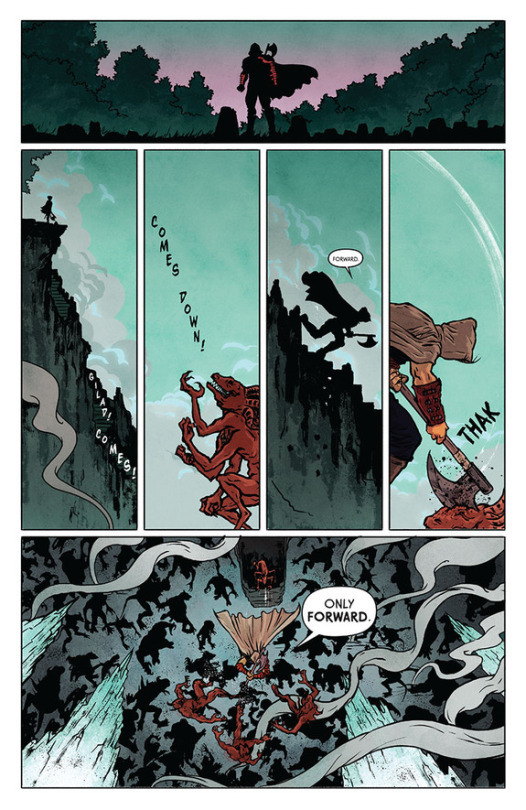
Raul Allen has done a bit of work for Valiant previously–single issues of Bloodshot Reborn and Ninjak–so his work will probably be familiar to fans of the publisher. That said, while he had impressed before, here he absolutely blew me away.
There’s a bit of a classical comics/pulpy influence in Allen’s style, which was particularly well-suited to the issue of Ninjak that he drew. In some ways, his work reminds me of a cleaner David Aja (high praise!), and yet, for all his greatness it never would have occurred to me how well-suited Allen would be for this kind of material. Who would’ve thought that he could draw the hell out of some cool demons? Seriously, look at this shit:

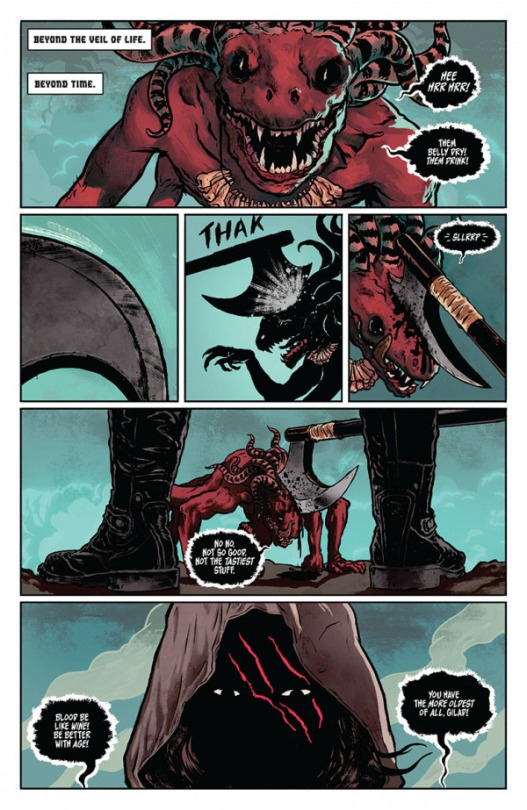
There’s a lot to like about Risen, but even if Robert Venditti’s excellent characterization and compelling story is not enough for you, then Raul Allen’s spectacular art is still worth a purchase Wraith of the Eternal Warrior vol. 1 in itself. Granted, I don't think the title is what a lot of fans expected when it was announced, but the quality is still exactly what everyone hoped it would be when Venditti took over.
#eternal warrior#Gilad Anni-Padda#wraith of the eternal warrior#Robert Venditti#Raul Allen#patricia martin#valiant comics#Valiant Entertainment#comics#comic reviews
1 note
·
View note
Text
Marvel Event Comic Roundup
I’ve never been a fan of comic events, especially those of the “Big 2″ as, more often than not, they seem to be driven by Marvel’s marketing and editorial staff rather than from an idea organically emerging from a particular story. Further, in recent years, the Marvel events have become more like “events,” since the promised changes in the status quo are almost always undone by the next “event” (arriving 6 months later). That said, the sales numbers do show that, for whatever reason, enough suckers people are still interested in these things. Hell, even I have a morbid curiosity and I usually hate them! So I took advantage of my Marvel Unlimited account and started reading through some of these. One rule that I had was that I refused to read any of the tie-ins unless I was already reading that series anyway, because I believe that the event mini-series should be able to stand on its own. Also, tie-in comics are generally terrible and I was willing to devote some time to this but I’m not going to read 100 comics to get the “full reading experience” of fucking Axis or whatever. Anyway, here’s my thoughts:

House of M (2005)
I chuckled a bit when I first saw the solicitations for Civil War II #0 announced that it would be from the same creative team–Brian Michael Bendis and Oliver Coipel–that “brought you House of M and Siege,” because weren’t those comics really bad?
Okay, that was an easy joke, but House of M isn’t exactly a masterpiece either. It’s another event in the tradition of Age of Apocalypse wherein an alternate reality is created and the heroes essentially have to undo it. That X-Men comic, which was perfectly solid but not really anything special, holds a fond place in readers’ hearts, because it’s length allowed the writers to really explore the details of the world itself while allowing various subplots that showed off every corner of that particular reality. House of M, on the other hand, only has eight issues to work with. Bendis further hurts himself by pacing the series really oddly; once the transformation into the new world takes place, the story sort of meanders showing snippets of various characters lives (Spider-Man is a beloved celebrity! Cyclops and Emma Frost are married!), before lurching into a boss battle. The middle section, which should be the meat of the story, is meant to show off the world, but since there’s only enough room to offer a couple panels for each hero, the reader is never able to become even slightly invested in the new status quo, making the whole endeavor feel pointless, especially since the boss battle that follows isn’t something that the readers haven’t already seen a hundred times.
The one redeeming quality of House of M is that it written before Marvel got into the “event comics every 9 months” mentality that they now have, so the aftermath (”no more mutants”) was allowed to linger for 7 years this comic ended. Admittedly some of this is due to sentimentality as the post-House of M time period was when I got back into reading comics, but I loved seeing the way that writers like Ed Brubaker and Matt Fraction actual usually this consequences of this book to tell compelling X-Men stories, which elevates House of M in my mind anyway.
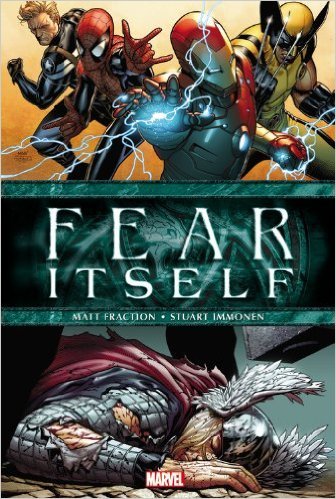
Fear Itself (2011)
Fear Itself is probably the most frustrating of all these events primarily because it should have been the best but was ruined by so many external factors. The core story–Odin’s brother is resurrected and distributes 8 magic hammers among various heroes and villains in order to destroy the Earth–doesn’t necessarily reinvent the wheel, but it’s a fun idea that also feels epic enough to actually be worthy of the “event” label, and there are a number of genuinely cool moments such as Sin destroying Captain America’s shield and Tony Stark teaming up with Asgardian blacksmiths in order to make magic weapons. The problem is that the core mini-series doesn’t stand on its own as several important events occur in the roughly 2,000 tie-in comics. Since there are roughly 2,000 of them, what was once a good story is overdone and diluted over so many comics, and the reader is essentially forced to choose between reading the tie-ins’ and being oversaturated with Fear Itself or having an incomplete reading experience with just the core title. At least we get seven issues of awesome Stuart Immonen art.
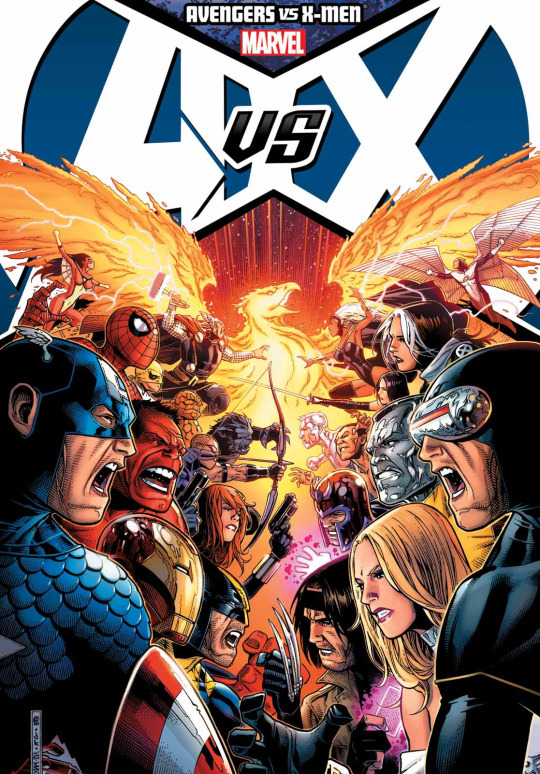
Avengers vs. X-Men (2012)
Considering that it was written by a rotating team of writers (Bendis, Fraction, Brubaker, Jason Aaron, and Jonathan Hickman) and drawn by three separate artists, Avengers vs. X-Men should have been awful, but it’s surprisingly okay! Aside from one glaring error (more on that in a minute), the story was a nice way to undo House of M. Yes, 12 issues is a bit too long (and to Marvel’s credit, they have seemed to have learned their lesson as subsequent events were scaled back to 8-10 issues), but the writers actually did something clever by having the two hero groups fight for some reason other than the cliche “misunderstanding or misinterpretation over something that appeared to have happened.”
The problem is in the book’s depiction of Cyclops. I’ve jokingly referred to AvX as The (Character) Assassination of Scott Summers by the Cowardly Marvel Writers and Editors, which should give you an idea of where this point is going. Granted, I realize that Cyclops is an incredibly polarizing character, and that I’m a flag-wavering member of the pro-Cyclops camp, but regardless of your own feelings towards him, it’s a nonsensical portrayal within its own context. Essentially, Scott Summers is not only correct about the Phoenix Force, he’s also the hero of the story in that he uses his powers to help all of humanity. Meanwhile, the Avengers are the aggressors who literally try to stop the X-Men from helping people. The writers then realize their mistake three-quarters of the way in and are forced to have Cyclops make an out-of-nowhere heel-turn.
It’s not a terrible story per se, but its inconsistency demonstrates the problems with Marvel’s approach to comic events. Namely, “we need to get from Point A to Point B (Marvel Now!) even if it doesn’t actually make any sense.”
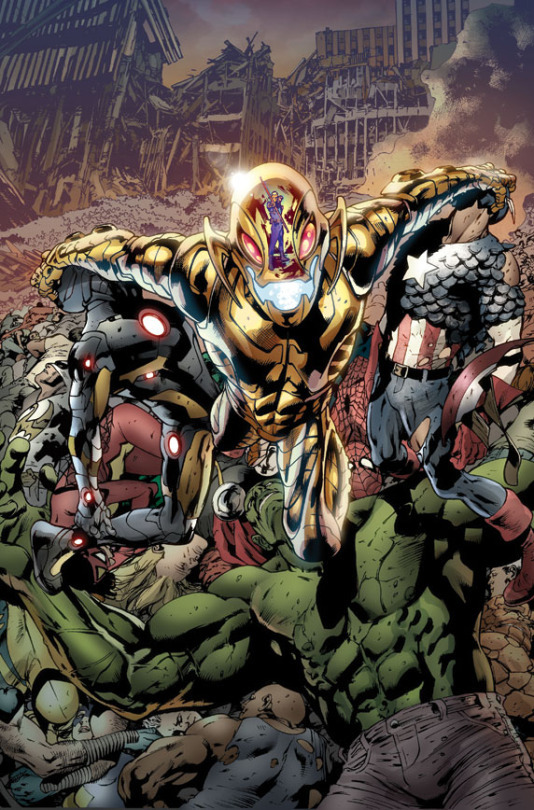
Age of Ultron (2013)
Look, I have no hate in my heart for Brian Michael Bendis. In fact, I think the record shows that, at least in regards to ongoing titles rather than event comics, I generally enjoy his work. That said, given his abysmal record, the man should not be let anywhere near any Marvel event. J. Caleb Mozzocco says it best:
The comic book series was written by Brian Michael Bendis, a very able, very experienced craftsman who has been writing these stories pretty much continuously for years now, and has thus had plenty of opportunities to find out what works and what doesn’t. Like most of Bendis’ big superhero epics, this one is really rather good, right up until the point where it stops being any good at all.
Mozzocco actually seemed to enjoy this comic more than I did as he says that it only falls apart at the end, whereas I disliked it almost from the beginning. Basically, it’s another apocalyptic future tale, which is one of only three plots that Marvel seems capable of using for their event comics (the others being “hero team vs. hero team” and “alien invasion”). Much like Age of Apocalypse and Days of Future Past, the heroes attempt to change the present by returning to the past, the twist being that in doing so, they bring about a different but equally bleak future, so they must return to the past once again. In other words, it’s Back to the Future Part II with Wolverine as Marty McFly and a free license to kill as many iconic heroes as possible since none of what happens will end up mattering anyway. Time-travel stories aren’t my thing to begin with, and this one doesn’t do itself any favors with some rather moronic plot points and an editorially-mandated appearance of Angela* that makes absolutely no sense.
Really though, Age of Ultron is just a weird comic. Avengers #12.1 acts as the prologue, but it was published a full 2 years before, and it feels like this was meant to be the end of Bendis’ run on Avengers (here’s a great breakdown of the comic within the context of Bendis’ full run), only it ended up being presumably delayed due to the Marvel Now! reboot. Further, either the artwork was already finished or Bendis was too lazy to change his script, and some of the roster choices reflect Avengers teams from his era rather than the Hickman era. It isn’t a big deal, but it does give the story an odd disconnect from the rest MU, but doesn’t that defeat the whole point of an event comic in the first place? Finally, as many others have noted, for a book in which Ultron is supposedly the antagonist, he almost never appears, being limited to proxies and about three panels worth of dialogue. Like nearly every other decision, it’s odd and makes me wonder exactly what was going through Bendis’ head as he penned this.

Original Sin (2014)
Of all the Marvel event comics that appear on this list, Original Sin is easily the strongest. Granted, it’s a Marvel event comic, which means that it’s still kind of dumb, but Jason Aaron at least provides a slightly different twist by making it a murder mystery, with major emphasis on the mystery/conspiratorial aspects rather than on large-scale fights.
The story begins with the death of the Watcher, and various hero pairings and trios are brought together in order to investigate seemingly-related killings.
As it turns out, Nick Fury has been operating as the MU’s “man on the wall,” taking down alien threats before they have the chance to invade through less than savory means, and he slowly dispenses clues revealing this to a select group of heroes–Doctor Strange, Emma Frost, the Punisher, the Winter Solider, Gamora, Ant Man (Scott Lang), and Moon Knight–because he wants one of them to carry on as his replacement. Actually, this part of the story is really what drives Original Sin forward rather discovering the identity of the Watcher’s killer as Aaron never bothers offering even a single suspect beyond the obvious culprit (no, a D-list villain doesn't count as a genuine suspect). In any case, it’s an interesting enough plot that works fine as long as the reader doesn't think about it at all, because the moment you do, you realize how stupid it is.
Like, why does the MU even need a "man on the wall?" Isn't turning back alien invasions something that the Avengers do every other week? Yes, Fury's unsavory methods might turn off certain moralists like Captain America, but what he's doing isn't any worse than what the Illuminati have been doing in Secret Avengers. So yeah, the comic is a little dumb, but compared to most event comics, this is incredible.
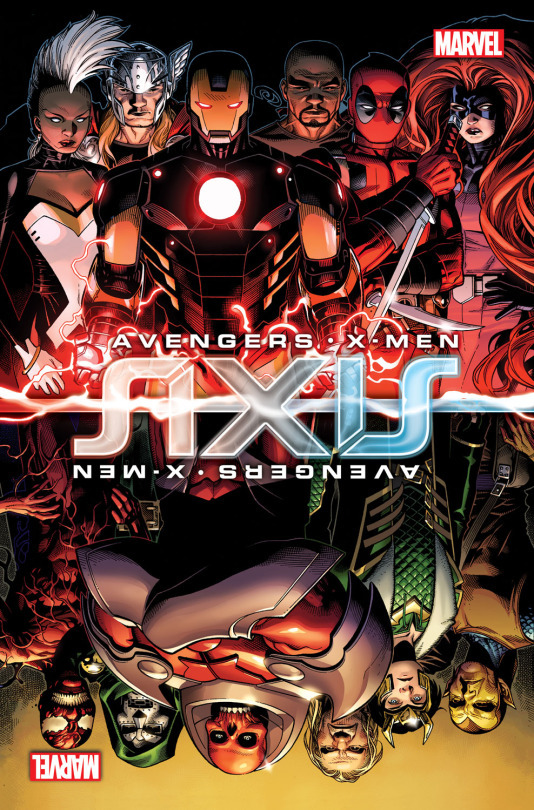
Avengers & X-Men: Axis (2014)
So first, let’s talk about good things in Axis: the title.
No, seriously, given the premise behind the comic, the title is really clever. The reader is meant to assume that it involves some kind of “Axis of Evil” or “Axis Powers” when instead it refers to the (very Dungeons & Dragons) idea that our natures lie along a kind of axis, which are inverted in this story. So, to continue with the D&D analogy, the Lawful Good Captain America becomes Lawful Evil for a few issues.
Unfortunately, aside from the smart title (and cool cover and logo) and some good dialogue here and there, just about everything else is pretty bad. It’s a shame, because of all the Marvel event authors, I’ve consistently liked Rick Remender’s work best. On the other hand, it actually isn’t surprising. If you’ve read a great deal of Remender’s work-for-hire comics, you’ll probably have noticed a pattern; his best work for Marvel has been when he’s written 2nd- or 3rd- tier titles such as his run on Punisher and his incredible Uncanny X-Force, whereas he has struggled when writing “A-list” comics such as Captain America and Uncanny Avengers. My best guess is that Remender excels when he’s more-or-less left to his own devices but flounders under the editorial mandates that come with writing the more “important” characters. Admittedly, this is pure speculation, but it seems as likely as a reason as any for why a writer as talented as Remender could produce something as poor as Axis.
Much like some of the other titles in this roundup, one of the problems with this story is that it doesn’t feel like a Remender comic. For all of its many (many, many) faults, Mark Millar’s voice was very apparent in Civil War,** whereas Axisis bland and lifeless could have been written by anyone. The “flipped axis” is essentially just a plot device to get the heroes to battle one another ala AvX and Civil War, and at no point does the comic even attempt to address any philosophical differences in the opposing sides or offer any insight into, for instance, human nature other than briefly addressing the ongoing “nature vs. nurture” argument surrounding Genesis/Apocalypse; instead it’s mostly mindless drivel.*** There is a small amount of fun in seeing “good versions” of some of the villains, but anyone who wasn’t reading Uncanny Avengers could skip this event and miss nothing.
*-A Spawn character from the ‘90’s, which Marvel acquired the rights to in a bizarre legal battle just before the publishing of this comic. Since there’s no logical reason for her appearing here, my best guess is that this is just Marvel rubbing their victory in Todd MacFarlane’s face.
**-Credit once again to J. Caleb Mozzocco for observing this.
***-Although I suppose one could successfully argue that this comic is better than Civil War, because it at least lacks the latter’s pretension. I’ll admit that it’s an argument that has some merit.
#Marvel Comics#marvel#house of m#Brian Michael Bendis#oliver coipel#fear itself#matt fraction#Stuart Immonen#avengers vs x-men#ed brubaker#jonathan hickman#jason aaron#john romita jr.#adam kubert#age of ultron#bryan hitch#Brandon Peterson#carlos pacheco#original sin#mike deodato#avengers & x-men axis#marvel axis#rick remender#jim cheung#terry dodson#leinil francis yu#marvel event
0 notes
Text
Random DC Title Roundup
Since I was fairly pleased with the way that the last roundup turned out and as I’m still nowhere near having completed a review for everything that I’ve read, it seemed like a good idea to continue with these roundups. On the plus side, they’ll be categorized?! Anyway, here’s a batch of DC comics that I’ve read over the past several months but was too lazy to write full reviews for:
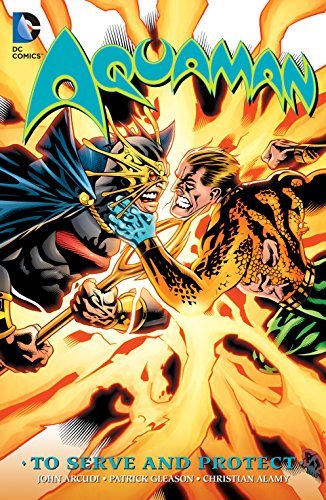
Aquaman: To Serve and Protect
One thing that I found myself thinking about as I read this book was how much the structure of comic plots have changed over the past decade. To Serve and Protect is technically the follow-up to Aquaman: Sub Diego (it was initially solicited as Sub Diego 2, but the name was later changed for unknown reasons, which is sure to confuse all but the die-hards who scrutinize every solicitation put out by DC*), although perhaps due to the departure of writer Will Pfeifer, nothing in this volume attempts to advance the primary question of who sunk San Diego and why.
Instead, the book is comprised of 5 two-issue arcs (John Arcudi writes the majority of the issues with John Ostrander and Marc Guggenheim contributing the first and last stories), which are only loosely-related and are devoted to side-plots. In other words, its structure is the complete opposite of contemporary comics, where writers “write for the trade” and structure their plotlines accordingly. These issues were written in 2004-2005, and while creative teams had an awareness that their work would be collected, it took several years for them to fully adapt.**
Regardless, Aquaman: To Serve and Protect is a fun read, which is to be expected from the likes of Arcudi, Ostrander, and Guggenheim. The art is also fantastic, especially since Patrick Gleason, Sub Diego’s primary selling point, returns for six issues. Fans of Aquaman should definitely pick this up.
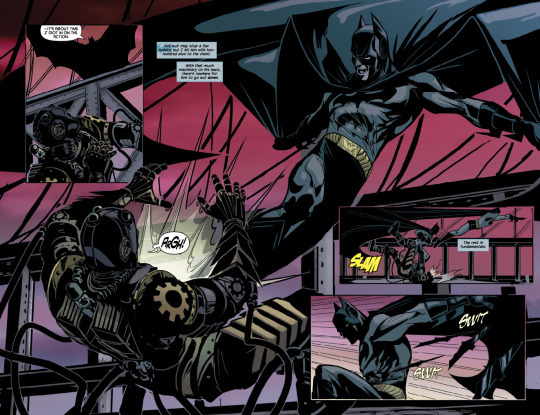
Batman: Gates of Gotham
This is a trade that I originally missed before it went out of print, but DC recently put out a new edition (the only surprise for me was that given that it's a Batman co-written by Scott Snyder that it took them this long) allowing me to finally get my hands on it. What really works for Gates of Gotham is the well-written backstory involving the city's history at the turn of the century, particularly as it involves Gotham's "founding families." Snyder actually referenced this series several times during the "Court of Owls" storyline. That editorial allowed him to do so in spite of the line-wide reboot demonstrates how good the historical elements of this story are. The villain isn't particularly memorable (but he does have a cool steampunk design), but the characterization is excellent and the overall plot is strong. Trevor McCarthy provides his usual dynamic art, which is especially appropriate towards a comic starring Dick Grayson, Tim Drake, Damian Wayne, and Cassandra Cain. This is definitely worth picking up as you can do far worse in regards to Batman comics
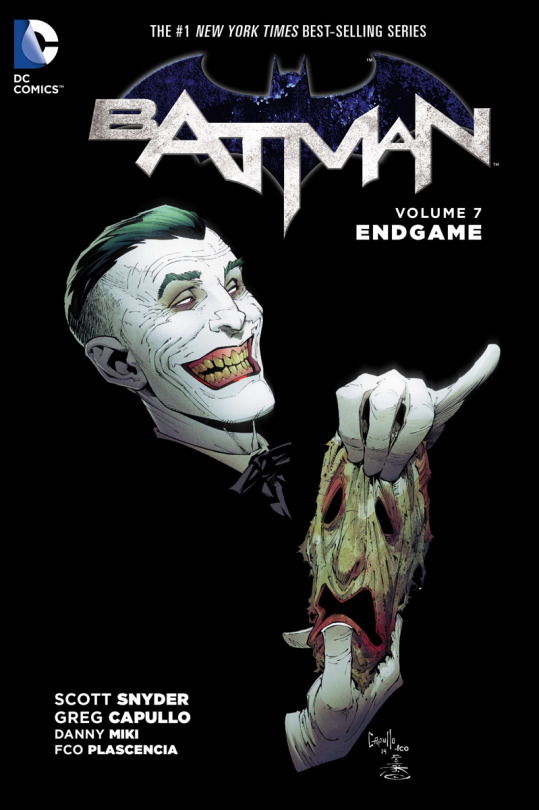
Batman vol. 7: Endgame
Considering how much I loved the previous battle between Batman and the Joker and how great Scott Snyder and Greg Capullo’s run has been as a whole, my expectations going into Endgame were sky-high, perhaps even to a level that would have been impossible to meet, but, this volume ended up being a slight disappointment. That’s not to say that volume 7 is bad; I don’t it’s possible for a Batman comic from the Snyder/Capullo team to be any worse than solid, but unlike Death of the Family, this story has several glaring story problems.
The Batman-Joker rematch was a source of concern for me given how iconic their battle had been, but it actually works, because Snyder makes it thematically different; Death of the Family was about the Joker’s (twisted) love for Batman, whereas Endgame stems from his anger. The problem is that Joker terrorizes the entire city of Gotham, which means accounting for the a potential Justice League intervention and taking out the members. Later, Batman is forced to battle all of them at the same time, which he does by busting out his Hulkbuster special Batman armor. As one reviewer on Amazon pointed out, the very concept of Batman simultaneously defeating the likes of Superman, Batman, Flash, and Wonder Woman seems a bit Batman fanboy-ish. Admittedly, it does make for a fun story, but it also stretches the reader’s suspension of disbelief. If this were the only problem, Endgame would still be quite good, but Snyder opts for yet another ambiguous ending (as he did with The Court of Owls, Death of the Family, and Zero Year), which ruined the book (for me, at least). The thing is, this was the Joker and Batman’s second major battle in Snyder’s run, and it really needed a decisive ending, even if that was as simple as the Joker locked up in Arkham Asylum. Instead, the finish was anticlimactic.
Anyway, long story short: this was another good installment of Batman, but not as good as what we’ve gotten before.
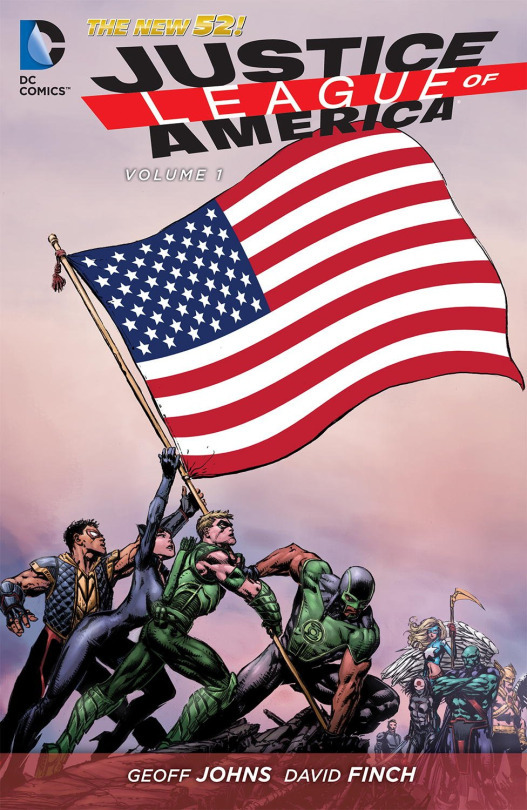
Justice League of America vol. 1: World’s Most Dangerous
Geoff Johns is one of my favorite DC writers, but for whatever reason, the man is just not suited to writing Justice League comics. The setup is interesting enough–Amanda Waller wants to assemble a kind of Justice League that can be under the government’s control and can take out their counterparts in the “actual” Justice League if need be–but the book never really goes anywhere and instead ends up telling a by-the-numbers superhero team versus supervillain team. The concept is there and other than Vibe I really like all of the characters, but the execution is lacking. It doesn’t help that the art is provided by David Finch and Brett Booth, two of my least favorite artists at DC. Even having picked it up at a 50% discount, I still feel I like overpaid for World’s Most Dangerous.

Superman Unchained
I love Scott Snyder’s writing and I really love Superman, so I was overwhelmed with joy when this series was announced. Even more surprising was that it actually managed to meet my sky-high expectations as Superman Unchained is every bit as good as I hoped it would be. My only criticism (and this is totally nitpicking) is that I would have preferred to read a Snyder-written Superman story where his adversary is one of the classic foes (Lex Luther, Brainiac, Bizarro, Zod, or Mr. Mxyzptlk) rather than another Superman analogue, which, especially in recent years feels incredibly overplayed.*** That said, the book is incredibly well-written, and Snyder is able to place both Lex Luthor and the Justice League in the story in a way that feels organic rather than tacked on.
The art will probably be one of the major draws for a lot of people. Personally, I don’t lose my mind over Jim Lee’s work the way that a lot of comics readers seem to, but it’s a good fit for this material given Lee’s ability to make comics feel grand and epic.
Also included in this trade are the roughly 10,000 variant covers for the series, some of which are really great. Although it’s a bit more expensive than the standard DC trade ($24.99 vs. $16.99), the quality of the story and art and the bonus material still make it a worthwhile purchase.
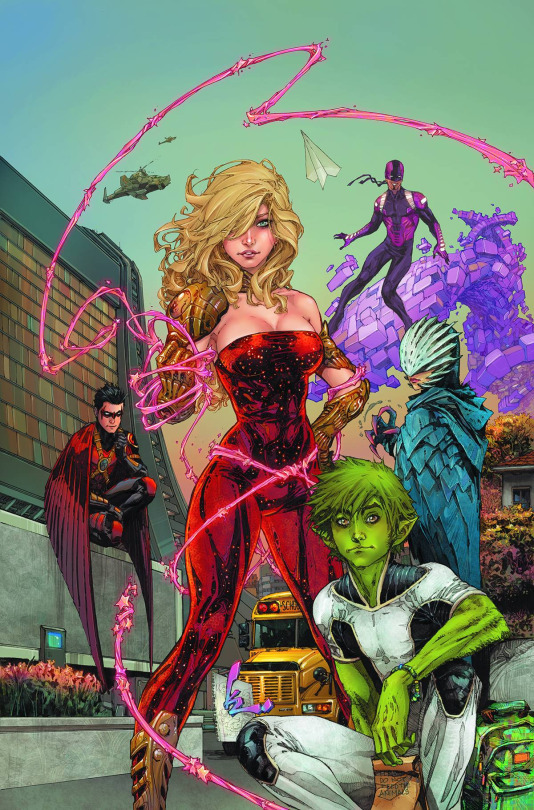
Teen Titans vol. 1: Blinded by the Light
The cover of the first issue may have stirred up a great deal of controversy on the internet, but the reality is that the content of Blinded by the Light really isn’t worth the passionate feelings one way or another. Will Pfeifer is a fairly good writer and this book is certainly better than the New 52′s first attempt at a Titans comic. That said, even at its best this book is totally bland. Pfeifer’s dialogue and characterizations are actually strong, but the plot is so dull that I forgot what happened the second I finished reading it. I suppose this is a decent pickup for a devoted Teen Titans fan put off by Scott Lobdell’s run, but there’s also so many good Teen Ttians comics out there already that’s it difficult to recommend this comic.

Gotham Academy vol. 1: Welcome to Gotham Academy
This book quickly became something of a cult hit among DC readers, so I was generally interested to check it out. Gotham Academy does have a lot of things going for it: the concept is basically “Hogwarts meets Batman,” which a fun idea for a book like this, the characters are likeable, the dialogue is snappy and clever, and there are a ton of easter eggs for Batman fans (particularly in regards to the identities of the various Gotham Academy faculty). So yeah, this comic is a lot of fun, and I can see the appeal.
The only real problem is the book’s odd sense of direction; it initially seems like there is a mystery involving Olive Silverlock, her mother, and the ghost of Millie Jean, only the book is constantly drawn into other sub-plots and side-quests. It would like if in Harry Potter and the Chamber of Secrets, everyone (including the characters and the reader) forgot about the Chamber of Secrets and Slytherin’s heir for large portions of the novel because it wasn’t as interesting as the Dueling Club or Quidditch or whatever. It makes for a bit of an odd plot, but the book is genuinely charming and it’s a very good choice to recommend for the types of comic readers who also enjoy a lot of YA fiction.
*-I was actively looking for book and figured it had been cancelled when it no longer appeared on Amazon. In fact, I only found it because I happened to search for “Aquaman Patrick Gleason” instead.
**-Geoff Johns’ run on Green Lantern is a really good illustration of this at work; pre-Sinestro Corps War is written in 1-3 issue story arcs, while post-Sinestro Corps War fit the trade format precisely with 5-7 issues.
#aquaman to serve and protect#aquaman#john arcudi#Patrick Gleason#john ostrander#chris batista#marc guggenheim#andy clarke#batman#batman gates of gotham#scott snyder#kyle higgins#TREVOR MCCARTHY#batman endgame#Greg Capullo#Geoff Johns#david finch#Brett Booth#justice leage of america#vibe#catwoman#green arrow#stargirl#martian manhunter#katanna#hawkman#steve trevor#green lantern#superman#superman unchained
1 note
·
View note
Text
Creator-Owned Roundup
Obviously, I’ve been really horrible about posting lately, which is due to a combination of an increased workload and my own laziness. So I’m way behind in my reviews (remember that the whole reason that I do this shtick is to force myself to write more regularly….oops) and in an effort to catch up, rather than writing out a full reviews for each of these, I’m just going to do a quick paragraph each.
Since I have an overwhelming backlog of unread digital comics, I decided to tackle those first (if nothing else, I can clear up some space on my tablet). I have a stockpile of creator-owned titles that I picked up from sales on Comixology and Humble Bundle, many of which I’ve been looking forward to reading for some tim but haven’t for some reason or another, and so I made those my priority. Due to the sheer amount of the comics that I own, I’ll probably be doing a few installments of these “Creator-Owned Roundup,” but for now onto the titles themsevles:
Black Science vol. 1: How to Fall Forever (Image Comics)
There’s a whole lot to like in Rick Remender’s story of “Dimensionauts” stranded with a broken device that warps them to random dimensions at odd intervals, wherein they’re forced to scavenge whatever parts or technology they can in order to fix the device; the characterization, pace, and tone are well-executed, and Remender’s dialogue is strong. The only problem is that the premise just doesn’t appeal to me personally.
Likewise, the art is something that I can appreciate on a technical level while simultaneously struggling to connect with. Matteo Scalera’s pencils are strong, and I like a lot of his designs (but something about the way that he draws faces makes them seem off to me). The coloring is meant to evoke a sci-if look and feel (at which it succeeds), however, there was a certain sameness in each dimension whereas I would have preferred to see Dean White really differentiate them using different color palettes.
All that said, I might still pick up either the next volume or the deluxe hardcover (which collects the first three trades) if there’s a sale or if the mood strikes me. Even if the concept and artwork doesn’t grab me, this is still a very good comic.
Fatale, Book 1: Death Chases Me (Image Comics)
Fatale is yet another entry into the crime/noir genre by frequent collaborators Ed Brubaker and Sean Philips. The pair clearly have an fond affection for the genre, having delved into noir many times before, and given both their talent and experience, the fact that this is a solid, well-crafted comic should surprise no one. The story itself is typical noir, sporting some of the archetypes of the genre such as the titular femme fatale, the idealist journalist who is slowly seduced, dirty cops, and a mob boss, but the presence of one character both of the story’s timelines, apparently unaged in over 60 years, immediately lets the reader know that the supernatural may also be at work. Adding a bit of Lovecraftian horror to a Hitchcock- and Maltese Falcon- influenced plot is rather clever departure, and the result is quite good. Fatale’s only failing is a typical trap of the genre; because of the need to keep the story hard-boiled with enigmatic people, it becomes difficult to really create memorable characters. As Roger Ebert noted about noir, the characters “have lifestyles, not lives”; however, he also added, “...it is because of style that we love them.” Needless to say, fans of noir (or of Brubaker and Philips’ previous comics) will surely love Fatale.
Southern Bastards vol. 1: Here Was a Man (Image Comics)
While I did like Fatale, I loved Southern Bastards. Both are heavily influenced by noir and crime and attempt to do something different with the genre (the former does so by tacking on supernatural horror elements, while the latter places it in the Deep South rather than a big city), but I feel that Southern Bastards manages to overcome one of the limitations of noir, i.e. the weak characterization, while Fatale falls into their trap. Admittedly, some of the personal appeal is in the book’s setting; as a Southerner myself (admittedly from a city rather than a small city), much of the story, such as the obsession with high school football, speaks to my own experience. That said, Jason Aaron has taken noir archetypes and Southern stereotypes and transformed them into fully-developed characters.
Also working in the book’s favor was that Jason Latour’s artwork, though not necessarily any better than Philips’, Moore’s, Scalera’s, or Guera’s, was more towards my personal taste. Seriously, this comic is gorgeous. All of the books in the roundup were strong, but it speaks to Southern Bastards’ excellence that it still manages to stand head and shoulders above the pack.
The Walking Dead vol. 1: Days Gone By (Image Comics)
The Walking Dead craze passed me by, because I’ve never really been interested in zombie stories, even well-told ones. That said, after having read the first volume, I can certainly see why the series has become a cultural phenomenon. It’s a smart, well-told story with strong character work that makes the reader genuinely care about the cast. The Walking Dead isn’t reinventing the wheel, but it does tell a better zombie tale than almost anything else.
Y: The Last Man vol. 1 (Vertigo)
At this point, I’ve been seriously reading comics for a little less than a decade and though I’ve tried to consume as many of the great comics, both modern and classic, as possible, inevitably there’s still quite a few that I’ve never gotten around to reading. Y: The Last Man is one that I feel especially guilt for never having read, because I think so highly of Brian K. Vaughn, but I picked up the full series digitally and I’m ready to dive in.
It’s not hard to see why this comic is so well-regarded; essentially, Vaughn takes a somewhat ridiculous concept--that all of a sudden, all of the male species on the planet die with the exception of a single man and a monkey--and actually sells it, because playing it straight and focusing more on a cast of intriguing characters. Further, the tone note-perfect, generally leaning more towards humor but never venturing into self-parody.
The artwork was one of the biggest surprises for me while reading Y. Artists in contemporary created-owned books often use their free will to push their work as far as possible and experiment (for better or worse), and so it’s a bit of a shock to see Pia Guera’s workmanlike pencil work,* which favors clear, no-frills storytelling over style. There’s nothing inherently wrong with either approach, but it is worth noting.
*-The contrast was especially stark as I read this immediately after finishing Black Science and Scott Snyder’s Wytches (to be covered in the next roundup).
#image Comics#vertigo comics#robert kirkman#tony moore#the walking dead#brian k vaughan#pia guerra#y the last man#ed brubaker#sean phillips#fatale#rick remender#matteo scalera#black science#jason aaron#jason latour#southern bastards#comic reviews
1 note
·
View note
Text
Review: Bloodshot Reborn vol. 3
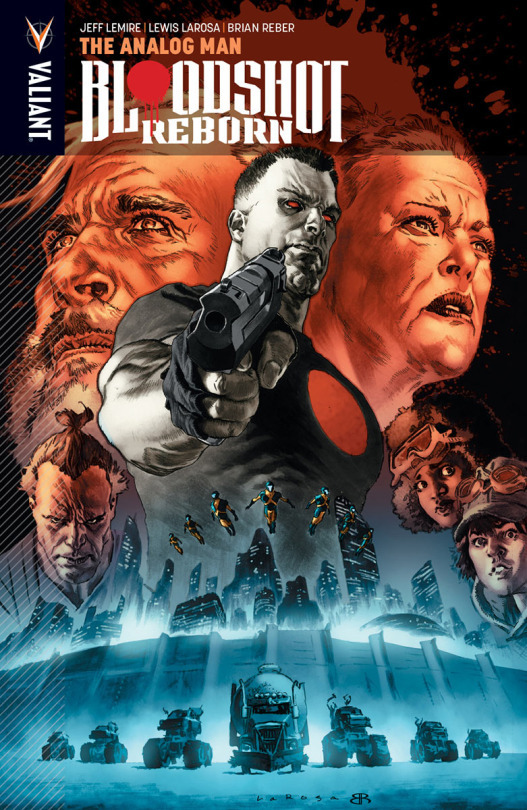
Bloodshot Reborn vol. 3: The Analog Man by Jeff Lemire (writer), Lewis LaRosa (artist), Stefano Gaudiano (inker), Brian Reber (colorists), and Dave Lanphear (letterer)
If you were to ask me what my favorite ongoing series was, my answer would be either Ninjak or Bloodshot Reborn. Through their first respective volumes, both were nothing short of excellent in both writing and art; however, with greatness comes increased expectations, and although Operation Deadside, the third volume of Ninjak, was a solid story, it felt like a disappointment relative to what came before it. Likewise, The Analog Man, although incredibly enjoyable, isn’t quite as strong as the two preceding volumes.

The Analog Man takes place 30 years in a post apocalyptic future where water is a scare commodity. Bloodshot and Magic are serving as the protectors of a small community, but problems with raiders and the return of Ninjak draw him back into the fray.
Obviously, the story is strongly reminiscent of Mad Max, which was a complaint among some readers who decried the arc for its unoriginality.* That said, the story itself is incredibly fun, and Lemire is rather clever in adapting the Valiant Universe into that particular kind of story. For instance, the raiding parties are Shadowman cultists and the only city is guarded by automated X-O Manowar drones made from nanite goo. Like many of the other good alternate universe stories** (Age of Apocalypse), the fun lies within these details, thereby making up for the predictable story beats. The ending might infuriate some, but it's fairly standard for an alternate universe story, and, again, the fun in this comic lies in the journey rather than the destination.
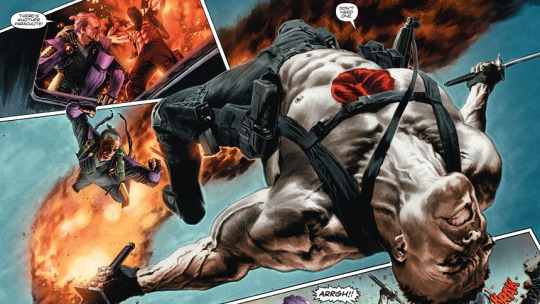
Regardless of how you feel about Lemire’s script, I feel like The Analog Man is worth recommending purely on the basis of Lewis LaRosa and Brian Reber’s artwork. LaRosa has been a Valiant-exclusive artist for some time although he has mostly been limited to cover work (he did draw the main story in Bloodshot #25!); given the level of detail present in his work, it probably shouldn’t come as a surprise that he doesn’t do more interior work in comics. That said, we really ought to just feel thrilled on those occasions when we do get extended amounts of his work. Part of the reason why the story worked for me was due to the way in which LaRosa sold it (seriously look at that image above).
Altogether, Volume 3 is good, if somewhat disappointing within the context of Bloodshot Reborn as a whole. The first two volumes not only told good stories but had real emotional depth to them, whereas this arc is just Lemire having fun while Lewis LaRosa rocks out on art. Personally, I'm perfectly content with comics that just want to tell an enjoyable story, but I recognize that others want more from their comics and will not be as predisposed to enjoy this book. That said, The Analog Man may be disposable entertainment, but at least it actually entertains.
*-Apparently some even declared it a rip-off of Old Man Logan, however, I have two counterpoints: 1) Old Man Logan was basically a rip-off of Mad Max anyway, so it's not like that comic was some bastion of originality. 2) Old Man Logan, like almost every other Mark Millar comic, was a piece of shit, whereas The Analog Man is actually good.
**-I guess that's a minor spoiler, but given the way in which this arc was written, it's impossible not to be aware that everything is not what it seems from the beginning, and it doesn't take a genius to guess the ending.
#bloodshot#Bloodshot Reborn#ninjak#mad max#old man logan#jeff lemire#Lewis Larosa#valiant comics#Valiant Entertainment#comics#comic reviews
1 note
·
View note
Text
Review: X-O Manowar vol. 11

X-O Manowar vol. 11: The Kill List by Robert Venditti (writer), Robert Gill, CAFU, and Francis Portela (artists), Bit (inker), Ulises Arreola, Andrew Dalhouse, and Brian Reber (colorists), and Dave Sharpe (letterer)
As Robert Venditti’s run on X-O Manowar winds down, the penultimate volume returns to almost the beginning of the series with another team-up with Ninjak much like their first meeting in Volume 2. Granted, it probably shouldn’t be that surprising given that not only does Venditti tend to structure his comics work for the long-term but also did something similar by echoing Homecoming in the previous volume.
Much like Enter Ninjak, The Kill List sees X-O Manowar and Ninjak (X-N Manojak?) team up in order to take down the Vine Plantings on Earth disguised as normal humans and acting under the radical leadership of Commander Trill. This time, however, the situations are reversed with Aric and Ninjak operating from a position of power, while the Vine plot to take down humanity in the shadows. The brilliance in this approach to writing is that it allows the author to show true growth in the character and the title.*
Aric himself is slightly less gung-ho, worrying over whether a group of Vine Plantings are innocent and expressing disdain for Ninjak’s more kill-happy ways. Further, the politics of the world play a much bigger role; there is continued tension between the Vine refugees and the Visigoths, and among the Vine there is strict philosophical divide between Commander Trill’s warlike faction and the pacifist group of the High Priest. Altogether, the plot is full of complexity and nuance, which demonstrates X-O Manowar’s own development.

If there’s failing to the book, it’s the way in which Venditti characterizes Ninjak and Aric’s relationship. Their interactions are icy and hostile, reminiscent of Enter Ninjak. The problem is that a great deal has occurred between the two since then, admittedly, elsewhere in the pages of Unity, The Valiant, Divinity, Book of Death, and Armor Hunters (much of which was written by Venditti himself), and given all that the two have been through Aric telling Ninjak that he “takes no pleasure in sitting at the table with you” seems completely uncharacteristic. Instead, they should be written as comrades with deep respect for one another even if they disagree with each other’s methods. Venditti does redeem himself somewhat by having Ninjak demonstrate unwavering loyalty towards Aric in the midst of a crisis, but everything leading up to it felt so incorrect that it took me out of the story, and thus, detracted from The Kill List as a whole.
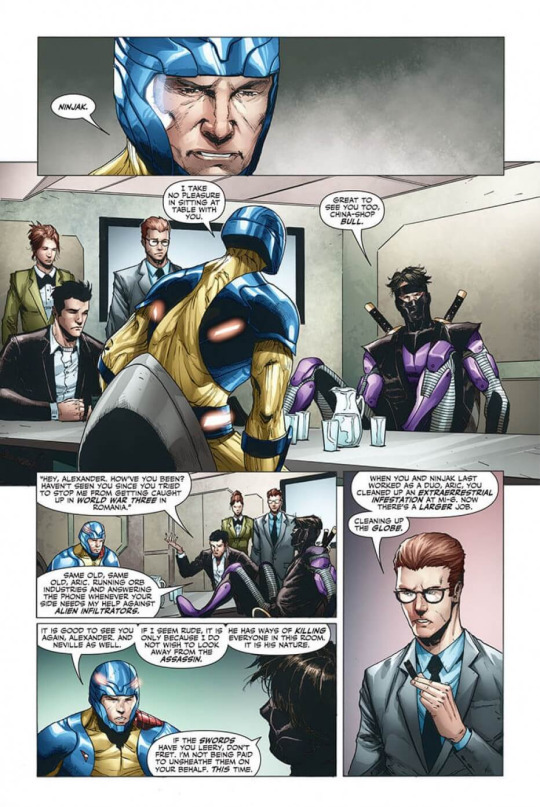
Artwork for the titular story arc is provided by rising star Robert Gill. Given how little he had done before signing with the publisher and that he was the featured artist for the 2015 event Book of Death, Gill represents true, home-grown talent for Valiant. It’s not hard to see why the publisher thinks so highly of his work; no one is better at depicting graphic violence without making it gratuitous.** However, Gill also excels conveying emotion and I love the way that he depicts the Vine council (which takes place in their hive mind). The Vine have always had a really interesting design, but it’s often difficult for artists to distinguish them. While Gill fares no better than Cary Nord, Lee Garbett, or Diego Bernard in this regard, he does do an excellent job of conveying the emotion through the facial expressions of the High Priest and Commander Trill. Ulises Arreola (who, between him and Brian Reber, seems to color just about every Valiant title nowadays) provides his usual excellent color work.
In addition to the primary story arc, also included in Volume 11 are the clunky-titled X-O Manowar 25th Anniversary Special and Commander Trill #0. The former (for which Shanhara #0 would have been a better title) tells the origin of the Manowar armor itself. It’s a nice little story, well drawn by CAFU, and I’m glad to see it reprinted here. Further, I like the way that Venditti has slowly been revealing information about the armors throughout the series, while still holding just enough back. Here for instance, we have a fairly detailed origin of only Shanhara, and the reader is still left wondering about Shanhara’s exact connection with the other armors that we saw in Armor Hunters and Dead Hand. The Commander Trill origin, drawn by Francis Portela, is solid enough and gives the reader a bit more insight into the primary antagonist of this volume.
Overall, this was another strong installment of X-O Manowar that made clever use of its own history–in mirroring Volume 2 and also with the addition of other elements from the past such as the revamped Armorines–that nevertheless manages to advance the story in an interesting way. As good as the book is though, the ending is a problem. Essentially, Venditti brilliantly raises the tension over three issues which leads to outright violence in the final issue only to have the conflict interrupted by the untimely arrival of a bigger threat. Obviously, the writer has a clear intention in ending the arc on a cliffhanger, but the problem is that nothing is really resolved, and a bigger threat just makes everything that lead up to it feel pointless and like a waste of time. Granted, this could actually work depending on what Venditti does in the next volume. Thus, I reserve the right to change my mind after Volume 12, but currently, the ending left a slightly sour taste in my mouth after an otherwise good read.
*-Something which, unfortunately, happens far too frequently in comics, mostly due to the necessity of keeping characters and properties intact. Stan Lee said it best when he said that comics “sell the illusion of change.”
**-Paul Tesseneer of the Valiant Central Podcast says that Gill has “the best non-gratuitous killshots in comics.”
#XO Manowar#ninjak#commander trill#Robert Venditti#Robert Gill#Francis Portela#Valiant Entertainment#valiant comics#comics#comic reviews
1 note
·
View note
Text
Review: All-New Ghost Rider vol. 1
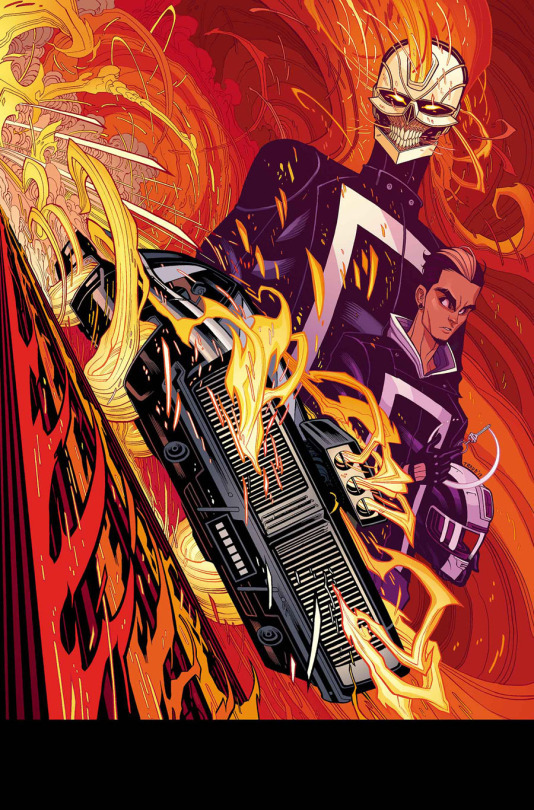
All-New Ghost Rider vol. 1: Engines of Vengeance by Felipe Smith (writer), Tradd Moore (artist), Val Staples, Nelson Daniel, and Ester Sanz (colorists), and Joe Caramagna (letterer)
What a difference an artist makes!
Personally, when I read comics, I tend to be a “writer’s reader,” which is to say that I tend to be more focused on the story and dialogue than the artwork. It’s not that I don’t admire great art or pick up on bad art, rather that I tend to get immersed in the story. That said, every once and a while, I’ll run into an artist whose work makes me stop and say, “Holy shit,” and Tradd Moore’s work on All-New Ghost Rider is like that.*
With his exaggerated and (sometimes) crazy lines, I would imagine that Moore’s art may not appeal to everyone. Granted, these (strawman) people are wrong, but I will reluctantly cop to his art being somewhat polarizing. Yet, even when conceding this point, it’s hard to argue that there is a more perfect choice for this comic than Moore, as his kinetic and frenzied work really conveys the speed of the action in the story. That’s not to say that Moore doesn’t also excel at other aspects of the story as his exaggerated facial expressions are actually pivotal for understanding the emotional beats of Engines of Vengeance (see the way in which he depicts Gabe, the titular hero’s younger brother).
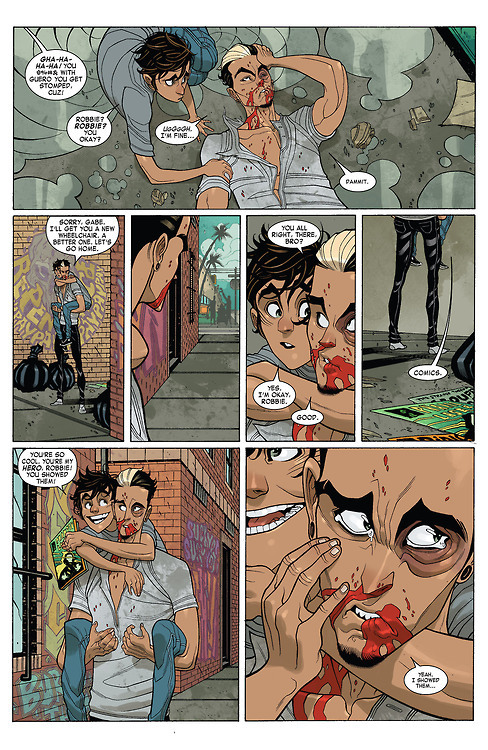
In a lot of ways Felipe Smith’s story stands in sharp contrast to Moore’s art; whereas, the art is all flash and style, Smith’s story is fairly straightforward: Robbie Reyes is a poor orphan in LA doing his best to take care of his developmentally disabled younger brother and get out of their neighborhood. To that end, he borrows a customer’s muscle car from his part-time job at a garage to use in an illegal street race, only a few unfortunate events lead to his death and resurrection as the Ghost Rider. Using his newfound powers, he then begins to combat some of the evil forces in his neighborhood.
If the premise sounds familiar, then it should, because it’s basically a modern retelling of Spider-Man’s origin story. This demonstrates that the story in Engines of Vengeance isn’t particularly innovative or original. That said, the story still feels fresh, perhaps because of its Latino protagonist, it's sensitivity in depicting the developmentally disabled**, or the way that Robbie's neighborhood and school feels authentic rather than like a collection of stereotypes. It could also just be the new character design, which really pops off the page, and the clever idea of having this Ghost Rider use a muscle car instead of a motorcycle.
In addition, Smith is a very good writer, and his characters are well-developed. I found myself more emotionally invested in Robbie and Gabe after a single issue than I was with Tony Stark after a full trade of the (very good) Invincible Iron Man. Simply put, when the characterization is this strong, the story doesn't need to be an action-packed epic; it merely needs to well-told, and in that regard Engines of Vengeance more than acquits itself.
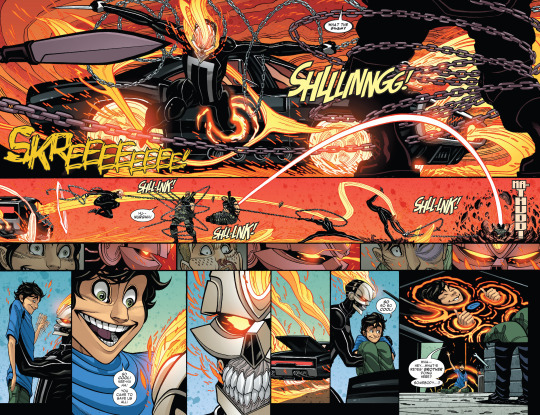
The writing in All-New Ghost Rider, while very good, isn’t necessarily better than Avengers Arena or some of the other really good Marvel NOW! titles, but what really separates it is the art. Unfortunately, Tradd Moore leaves with this volume, but his short tenure was enough to help retain interest while the series found its footing story-wise. At this point, I’m emotionally invested enough in the characters that I would settle for even (gulp) Greg Land, but instead the get the very talented Damion Scott and even Smith himself. Regardless, Engines of Vengeance is in the top-tier of Marvel NOW! titles.
*-Other artist who also fall in this category are Francis Manapul, Frank Quitely, J.H. Williams III, and Mike Allred.
**-As someone who used to work with developmentally disabled adults and children, I have a soft spot for any stories in which they are depicted in good light.
#all new ghost rider#ghost rider#robbie reyes#felipe smith#tradd moore#marvel#Marvel Comics#comics#comic reviews
43 notes
·
View notes
Text
Review: Avengers Arena vol. 2
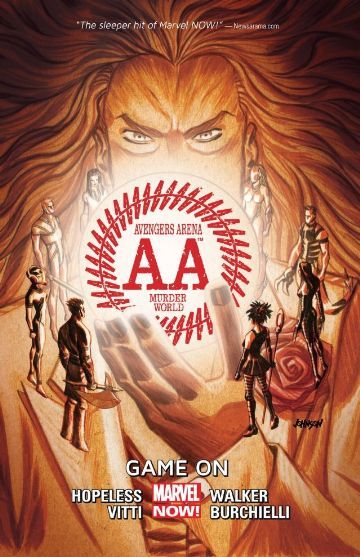
Avengers Arena vol. 2: Game On by Dennis Hopeless (writer), Kev Walker, Alessandro Vitti, and Ricardo Burchielli (artists), Jason Gorder (inker), Jean-Francois Beaulieu (colorist), and Joe Caramagna (letterer)
The first volume of Avengers Arena began its Hunger Games/Battle Royale-esque story surprisingly slow; unlike its obvious influences, as almost all of the “contestants” of Arcade’s newest Murderworld were content to try and wait out the game rather than kill one another. That said, the series really began to shift into the high gear with the final issue of Kill or Die, which saw one of the powerful characters killed off in a shocking manner. Further, the identity of the one character actually playing the game (i.e trying to kill the others) was revealed, which means that in Game On, the characters finally begin to move against one another openly.
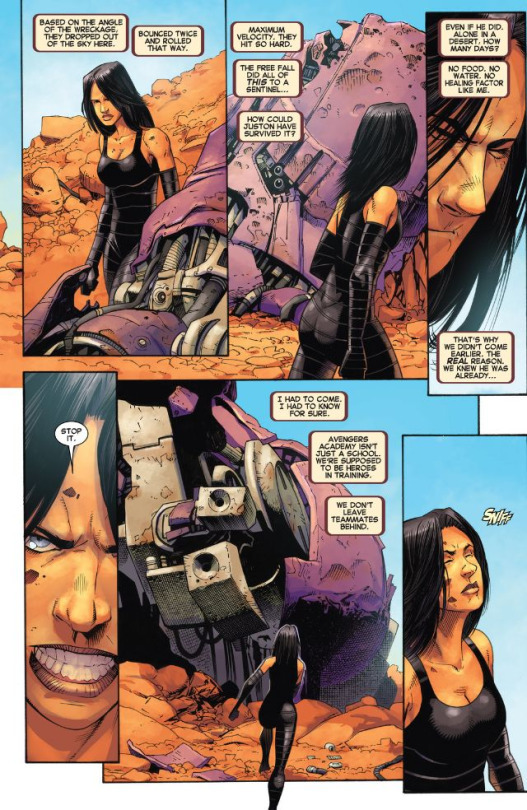
One of the interesting things that Hopeless has done with the series (which really comes to fruition in this volume) is making Katy/Apex the “bad guy” of the title (other than Arcade, of course). Naturally, the reader would expect someone like X-23, Captain Britain Jr., or Darkhawk to be the most formidable contestants, but instead with her gift for manipulating both people and technology, she actually proves to be one of the best equipped to survive Murderworld. Further, as certain details of her backstory emerge, the choice to simply kill her isn’t quite so easy for the other characters.
While the plot remains engaging, what has kept this series from devolving into mere exploitation has been the excellent character work from the beginning. Hopeless continues to have each issue narrated by a different character. For unknowns such as Katy or Death Locket, this technique has been vital in fleshing them out, but even more well-known commodities such as Nico have benefited greatly from it.
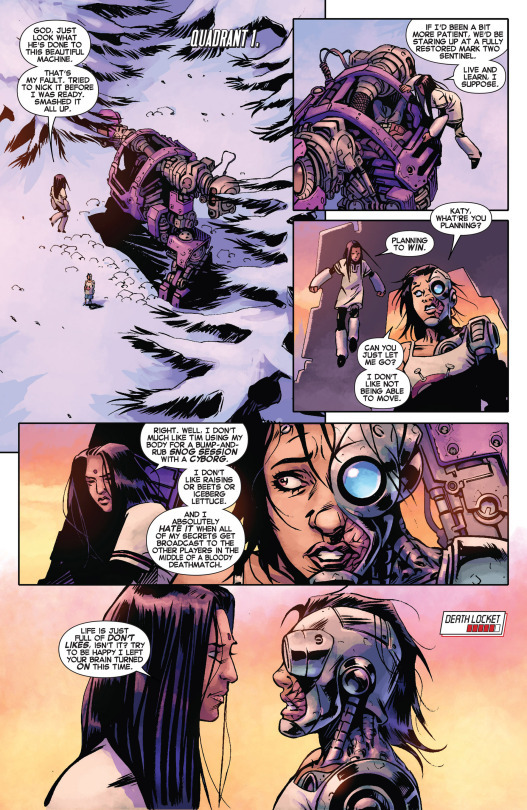
The art team of Kev Walker and Alessandro Vitti return once again for this volume, splitting issues, although even then Ricardo Burchielli was still called upon to fill in for a couple of issues. The artwork isn't necessarily remarkable, but it's solid, tells the story well, and the the artists' styles are appropriate for the material. For a mid- or lower- tier title such as this, the overall standard of quality is quite high.
Anyone who enjoyed the first arc of Avengers Arena will surely be satisfied with Game On. There's one volume remaining, and, given how many characters still remain, Volume 3 will surely be quite action-packed, as Hopeless will need to tie together a lot of threads before the series can end. That said, thus far he's proved that he's more than capable of doing so.
#avengers arena#the runaways#marvel runaways#Avengers Academy#x 23#laura kinney#Nico Minoru#chase stein#captain britain#darkhawk#arcade#murderworld#Dennis Hopeless#kev walker#alessandro vitti#marvel#Marvel Comics#comics#comic reviews
2 notes
·
View notes
Text
Review: Ivar, Timewalker vol. 3
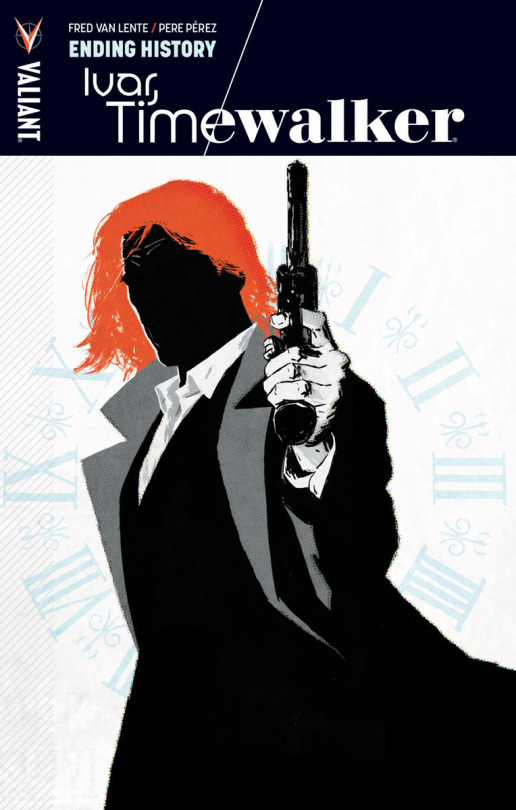
Ivar, Timewalker vol. 3: Ending History by Fred Van Lente (writer), Pere Perez (artist), Andrew Dalhouse (colorist), and Dave Sharpe (letterer)
The final volume of Ivar, Timewalker also might be the best. Fred Van Lente not only wraps up the plot of his Doctor Who-esque epic but also ties up the story emotionally building upon themes that we first saw in Making History.
(Review Contains Spoilers)
Van Lente has always been one of the writers that I admire most in comics; not only is he one of the funniest writers in the medium, but he also has a knack for taking interesting academic theory and applying it in his stories in a fresh, exciting way that doesn’t feel unnatural (or worse, boring). In Magnus: Robot Fighter, he used both the Singularity and the “uncanny valley” to great effect, but with Ivar, Van Lente has opted to tackle both one of science-fiction’s most overused plot devices in time-travel and superhero comics’ most overused elements--the multiverse--but does it in an interesting way (that could very easily be seen as mocking Marvel and DC, particularly recent events like Convergence and Secret Wars). For instance, Van Lente and artist Pere Perez actually utilize the idea that the multiverse allows for every single possibility to throw in several wonderful visual gags.

That said, as great as some of the humor is in this comic, there's also some real emotional heft to this story. The Nil (who, if you'll remember, were first introduced by Van Lente back in the second volume of Archer & Armstrong) are trying to destroy everything basically as is their wont, and while Ivar and Neela have found a solution, an unfortunate side-effect is that they will never have any memory of one another. Thus, they end not only history in general, but their history as well, and since Van Lente has spent the previous eight issues developing their relationship and getting the reader invested, the prospect of them losing each other actually draws the desired reaction from the reader.
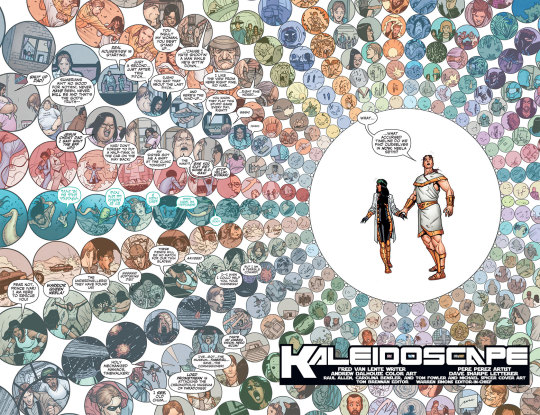
For the final volume, Van Lente is again paired with frequent collaborator, Pere Perez, who also drew large portions of Archer & Armstrong, and has worked on basically every Valiant property at some point or another. Personally, I've always been a huge fan of his work, and I'm always excited to read anything that he draws. As I've mentioned before, he draws in a similar cartoony style to Clayton Henry (who was Ivar's initial artist), and he's a master at both conveying action and humor. That said, he's also excellent in his ability to show emotion in his characters through their body language and expressions, which is really important for an arc which is as poignant as Ending History.
Additionally, the nature of the script also allows Perez to play with some interesting panel layouts (see above). Yet, in spite of their complex design, they flow in a natural way that allows the reader to stay immersed in the story. This is worth noting, because more often than not, when artists attempt these kinds of creative layouts, they are often difficult to follow as a reader, which can be distracting and overwhelm the story.
Colorist Andrew Dalhouse returns from the previous volume and delivers his usual excellent standard. He's had a lot of experience on superhero comics coloring the last two volumes of Unity for Valiant* as well as doing some work on The Flash, and his experience shows with a bright, vibrant color palette that really pops off the page.
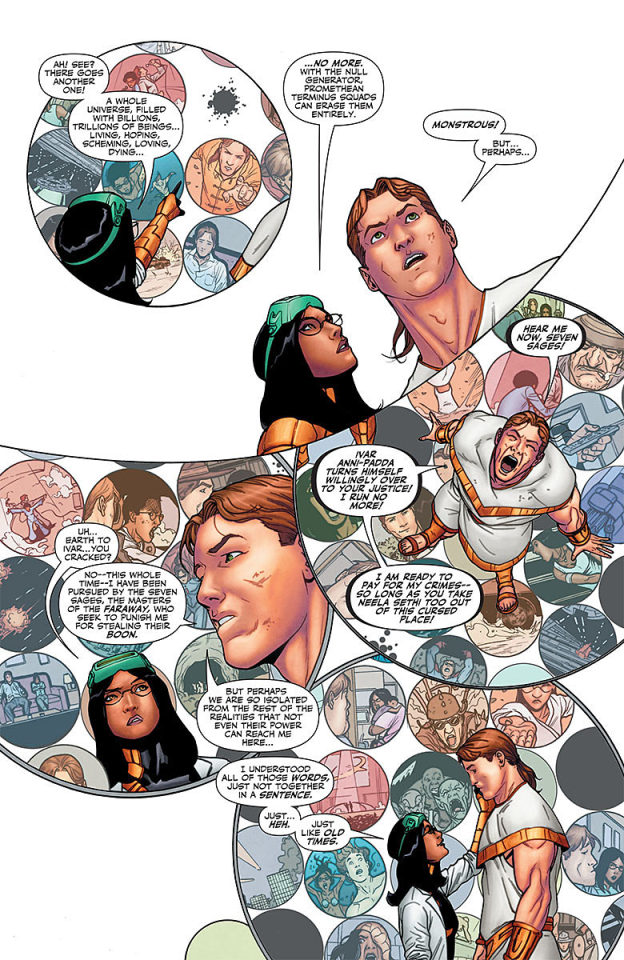
More than anything, the excellence of Ending History was a reminder of just how consistently great Ivar, Timewalker has been as a series. Although I’ve always enjoyed the title, I think I took its quality for granted, because the character and the concept never appealed quite as much as, say, Ninjak. The reality is that the title was every the equal of the other Valiant Next comics: Bloodshot Reborn, Divinity, Imperium, and Ninjak. That it never received the same accolades (or sold as well, for that matter) as those books doesn’t diminish its quality.
*-It seems like he's been a lot of work for the publisher recently. Is he on an exclusive contract? Maybe someone at @valiantentertainment can tell me.
#ivar timewalker#archer & armstrong#Fred Van Lente#pere perez#Valiant Entertainment#valiant comics#comics#comic reviews
6 notes
·
View notes
Text
Review: Invincible Iron Man vol. 1

Invincible Iron Man vol. 1: Reboot by Brian Michael Bendis (writer), David Marquez (artist), Justin Ponsor (colorist), and Clayton Cowles (letterer)
This was not a book that I intended to read for a number of reasons. For one, Invincible Iron Man has been branded the “flagship” title of the new “All-New, All-Different Marvel,” (much like Hickman’s Avengers was the “flagship” of Marvel NOW), which means that it figures to be at the center of the Marvel Universe. Practically, that means that it will also tie-in to every stupid crossover, and therefore will constantly be upended and have its status quo fucked with (whoops, we’re nine months in and that’s already happened). Simply put, with where Marvel is at right now as a publisher, the best possible thing you can do is read the titles deemed not important enough to “matter,” so you don’t have to deal with endless crossovers and unwanted status quo changes. Also, I’ve never been a big fan of old Shellhead to begin with. In the end, however, curiosity and a surprisingly good review from someone who tends to like Bendis’ work less than I do was enough to convince me to read it.
One of the biggest appeals of Reboot for many readers is that it doesn’t read like a typical Bendis comic (and I say that as someone who has enjoyed some of his work); while Tony Stark provides the narration, it’s no more wordy than your typical Marvel comic, and there aren’t any long monolouges. The characters all have distinct voices, and while technically speaking there isn’t much to the plot, everything moves along at a breezy enough pace that it doesn’t feel decompressed. There’s also a great deal of humor in this comic (which is one of Bendis’ most underrated skills) with the protagonist bearing a much closer resemblance to his sarcastic, wise-cracking cinematic counterpart rather than the more arrogant version of the comics. In fact, more than anything, Volume 1 reads like a comic for people who like the Iron Man films.*
Essentially, the plot sees Iron Man doing battle with an old enemy/lover, Madam Masque, who is stealing powerful magical items, which necessitates an alliance with the renewed (and handsome) Victor Von Doom and a consultancy with Doctor Strange, while simultaneously wooing Dr. Amara Perera and just being Tony Stark. Bendis uses his privileges as de facto “head Marvel” writer for good, including cameos from the aforementioned Doctor Strange in addition to Thor and Mary Jane Watson. Admittedly, the writer also plays fast and loose with continuity (although I suppose this can be explained away with the simple excuse “Secret Wars” and a shrug), but it’s not like A) I’m a stickler for continuity myself, and B) I was really keeping tracking of Iron Man prior to Secret Wars anyway.
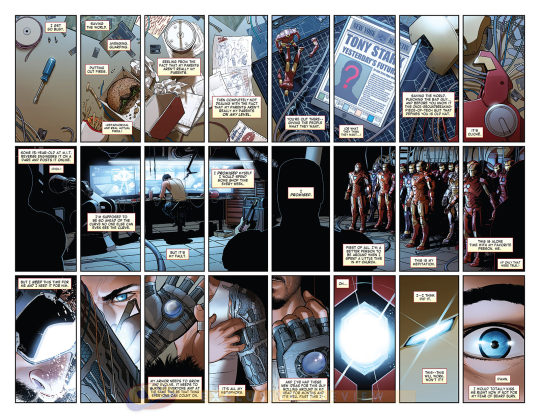
Frequent Bendis collaborator David Marquez provides the artwork for Reboot, and he does a lot of great work. He obviously put a lot of thought into his panel layouts, devoting a couple double-page spreads into being broken down into small panel grids as seen in the photos above. This strikes me as a great means of conveying Bendis’ scripts and narration (even if, as I already said, Invincible Iron Man isn’t a typical Bendis comic). His digital penciling is also a good fit for Iron Man, giving the comic a slightly “tech-y” look, and he’s fantastic at conveying humor, especially through facial expressions (check out Doctor Strange’s reaction below). Further, the colors from Justin Ponsor really pop off the page making the comic feel like a bright, superhero book matching the tone of the films. One good thing about reading Bendis’ Marvel work is that his position within the publisher assures that he only works with the best art teams.
I would also be remiss if I didn’t post one of my three favorite pages from Reboot:
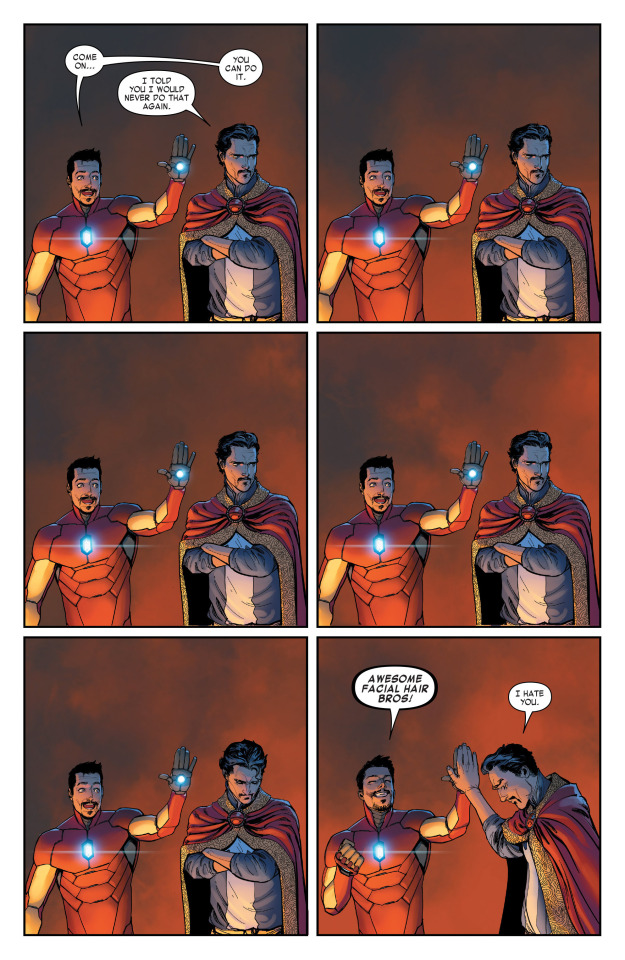
On its own, I really cannot recommend Reboot enough. That said, anyone getting into this title ought to know that shortly after the title ties into Civil War II, which is almost guaranteed to be awful given that it’s a Marvel event comic,** and shortly afterward Tony Stark “retires” and Riri Williams takes over.*** So, in other words, if you like the direction of this comic, too bad. Remember, this is why you don’t read “important” Marvel titles.
*-Again, as someone who likes the Iron Man movies but never cared for the comics, this marks the rare instance where I’m actually in Marvel’s target demographic.
**-And based on the detailed recaps, apparently it is terrible.
***-Although since this is Marvel, we know that Tony Stark will just come back in 18 months (with a new #1!) anyway, leading both bigots and SJWs to wonder why they even bothered making a fuss about it. See also: “black Captain America” and “lady Thor.”
#Iron Man#invincible iron man#Brian Michael Bendis#david marquez#victor von doom#whitney frost#madam masque#doctor strange#mary jane watson#comics#comic reviews#marvel#Marvel Comics
0 notes
Text
Review: Ninjak vol. 3

Ninjak vol. 3: Operation Deadside by Matt Kindt (writer), Doug Braithwaite and Juan Jose Ryp (artists), Brian Reber, Ulises Arreola, and Soto (colorists), Taylor Esposito and Dave Sharpe (letterers)
Ninjak has quickly become one of my favorite titles, so much so that even when it was announced that the third arc would be the return of Shadowman (my least favorite Valiant title), I was still excited. Unfortunately, the curse that is Shadowman has managed to affect even Matt Kindt, as Operation Deadside isn't quite as strong as the two previous volumes. That said, this is still a solid story, and it's easily the strongest Valiant story to take place in Deadside.*
Volume 3 begins with Neville Alcott desperately approaching Ninjak with a new mission; a figure from Deadside had suddenly appeared and stolen certain items, which MI-6 wants returned. MI-6 had previously sent a team led by Punk Mambo to retrieve it, but only Mambo managed to escape, forcing Neville to turn to Ninjak.
Despite not quite living up to the high standard of the first two arcs, there' still a great deal to admire in this story. Ninjak, with his hatred of magic, serves as a kind of stand-in for the reader. In an interview, Matt Kindt mentioned that he had never had any interest in "magical" stories and that Operation Deadside was his attempt to make sense of both that kind of storytelling and of Deadside itself (which had never been very well fleshed-out to begin with). Thus, the reader is essentially getting an outsider's perspective of this world and it's more effective, because we see Kindt attempting to establish rules and Ninjak understands just as little as the reader. Further, this also allows Kindt to insert a great deal of humor into the story, as we see Ninjak preparing for the worst by bringing every gadget imaginable (most of which ultimately doesn't work) while griping about how much he hates magic and distrusts everything in Deadside.
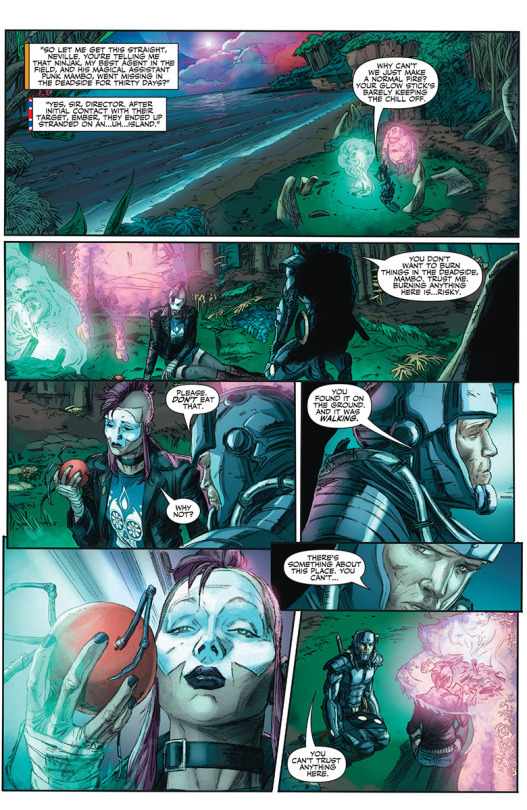
Yet, the story fails somewhat due to a lack of depth. We are told Magpie/Shadowman's man, and the back-ups, expertly drawn by Juan Jose Ryp, are meant to flesh his character out to some degree, but, for me at least, it doesn't totally succeed. Had this been written by someone else, I might have enjoyed it more, but coming from the man who expertly characterized a villain and had them fight Ninjak in a single issue (repeating the process four times) in the The Shadow Wars, the plot of Operation Deadside just feels slightly shallow. All that said, there several genuinely cool moments and ideas (Mambo "riding" a Loa, for instance) in this volume, and it's still better than almost any another comic being published. Ultimately, its failing are probably the result of unrealistic expectations on my part as a reader.
Part of the problem may also have been in the artwork. Doug Braithwaite is a phenomenal artist--given his status as the "event artist," Valiant clearly consider him to one of their best--but this is one story arc that his style just doesn't feel suited towards. Braithwaite is a master at depicting large-scale action sequences, but he's at his best when he's drawing more grounded subjects (I'm thrilled that he'll be drawing an arc of Bloodshot Reborn in the near future); whereas, I feel like an artist with a more whimsical or (for lack of a better word) fantastical style would have been better suited to the material. It's especially problematic, because Juan Jose Ryp, who is exactly the type of artist that this arc needed, draws the back-ups, and the contrast is hurts Braithwaite. Again, that's not to say that the art is bad--on the contrary, with Braithwaite, you're guaranteed that the art will always be at least very good--but, much like the writing, feels like it could have been even better.
If there's a saving grace, it's that I like Brian Reber's color palette. Instead of falling into the easy trap of depicting Deadside in a purely monochromatic palette, and instead works in some unusual color choices (just look at the last panel in the picture above; that's some damn good coloring there). On the occasions when Reber does make use of monochromatic backgrounds, he'll also include a fairly striking color to act as a contrast and draw the reader's eye to the object in question

While this volume couldn't quite live up to my expectations, it was nevertheless another good addition to the series and highlights that Ninjak (the title) is capable of more than just espionage stories. More importantly, the end of the story has put Jack Boniface into a more accessible place than he had been previously. Also, in spite of its flaws, this volume did more for Shadowman than the previous five volumes of the title had done, and I actually find myself interested in reading a new Shadowman comic for once (preferably written by either Jeff Lemire or Joshua Dysart among the current Valiant creators). Given where I was when I started Operation Deadside, that's no small feat.
*-And I say this even having enjoyed The Death-Defying Dr. Mirage.
#ninjak#shadowman#punk mambo#Matt Kindt#Doug Braithwaite#juan jose ryp#Valiant Entertainment#valiant comics#comic reviews#comics
0 notes
Text
Review: Unity vol. 7
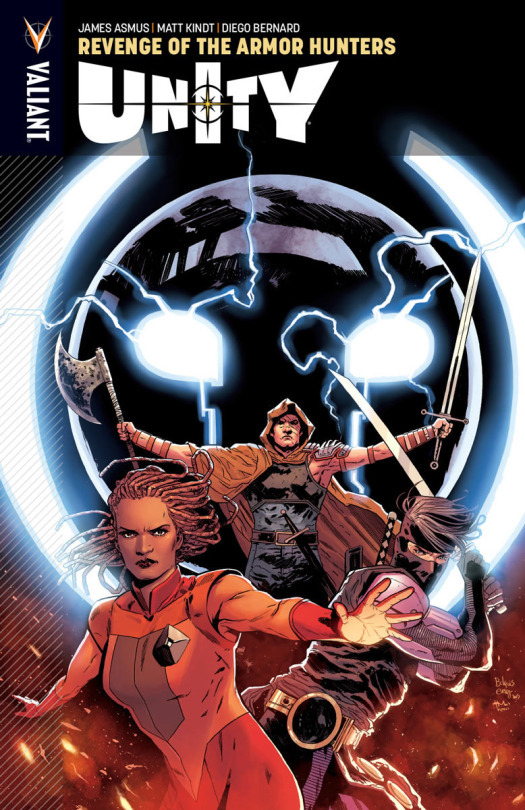
Unity vol. 7: Revenge of the Armor Hunters by James Asmus (writer), Diego Bernard and Karl Moline (artists), Glauber Matos, Denis Freitas, and Mark Pennington (inkers), Andrew Dalhouse and Allen Passalaqua (colorists), and Dave Sharpe (letterer)
The final volume of Unity stands in sharp contrast to the first. Whereas To Kill a King was a massive event to kickstart the beginning of the Valiant Universe's answer to the Avengers or the Justice League, this final volume is something entirely different.
Some of that is out of necessity as the title failed to catch on with readers and was consistently one of the publisher's lowest-selling titles (in comparison, could you imagine what would happen if Avengers or Justice League were at the bottom of Marvel and DC's sales?). While I enjoyed much of Matt Kindt's work on the title, one of the major issues was that the Unity team almost never fought the kind of world-threatening adversaries that one would expect a super team to.* Given that, a complete shift in tone--the final issue is almost entirely comedic--was probably a smart move, as it gives the book a certain amount of intrigue.
In addition to writing much of the final issue, James Asmus also writes the titular two-arc story. Asmus, who also writes Quantum and Woody for Valiant, is easily one of the three funniest writers in comics, but there’s no humor to speak of #23 and #24. Instead, we get a very straightforward story wherein the surviving members of the Armor Hunters, Quartz and Helix, commandeer Gin-GR.
It’s a good, enjoyable story, and it’s nice to finally have the loose ends of the Armor Hunters tied up. I was also surprised, because if I hadn’t already known that Asmus was the writer, then I never would have guessed it, which demonstrates that there’s much more to him than humor.
“Woody and Quantum in United We Rock!” (James Asmus, Dan Schkade, Allen Passalaua, and Dave Lanphear)
Essentially, this story acts as the framing sequence for the majority of #25, and it often appears in between the other stories and at the finish. Essentially, Quantum and Woody (well, mostly Woody) are trying to sell a movie pitch based around Unity, by leveraging their status as reserve members of Unity. As with most things written by James Asmus, it’s genuinely funny, and the framing device is a clever way of justifying the stories that follow with some, such as “Old Man Warrior” and “Book of Death 2,” making good use of it.
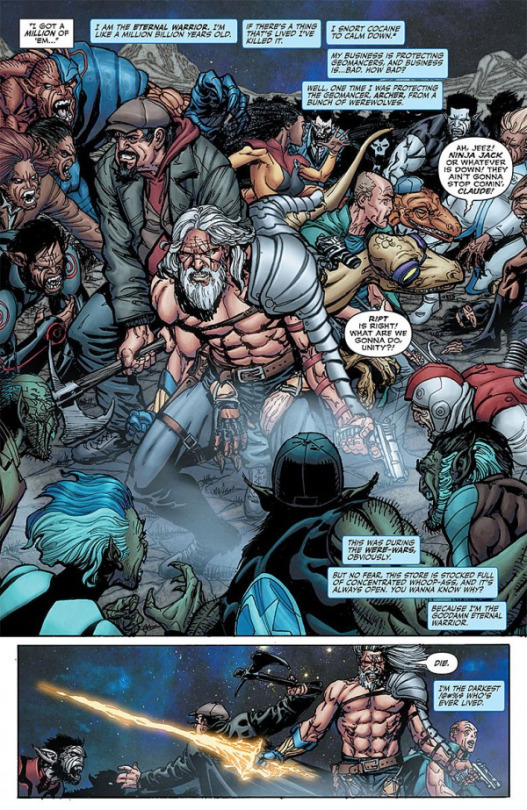
“Old Man Warrior” (Donny Cates, Eliot Rahal, Bart Sears, Andrew Dalhouse, and Taylor Esposito)
The monster-ification of the Valiant Universe is a funny enough concept on its own, but the punchline at the end of the comic is what really makes it. More importantly, this comic has Mark Waid’s greatest line of dialogue: “I SNORT COCAINE TO CALM DOWN.”
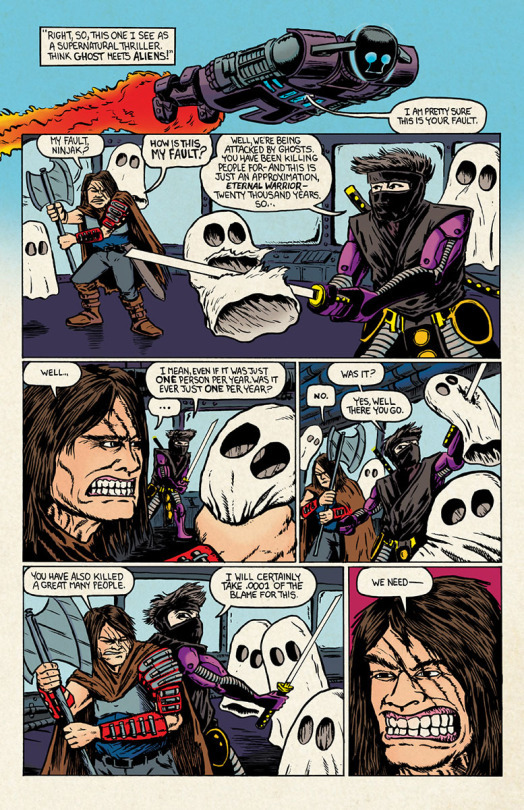
“Book of Death 2: The Bookening” (Justin Jordan, Rafer Roberts)
This is the longest Jordan/Roberts collaboration yet, and it’s a pleasure to get 6 pages of Rafer Roberts’ artwork. There’s a few good one-liners in here (with my favorite being the second to last panel from the page above).
“Let’s Take….A Look Inside Gin-GR!” (Daniel Kibblesmith, Pere Perez, Daniela Miwa, Dylan Todd)
Longtime readers of this Tumblr will know that I love almost nothing more a layout of a facility or boat, so naturally I loved this on its own, and the humor was an added bonus.
“Livewire in: ‘Stranger Danger!’”/“Ninjak in: ‘Just Say Maybe!’”/“X-O Manowar (and Faith!) in: File Scaring!’” (Daniel Kibblesmith, Karl Moline, Andrew Dalhouse, and Dave Sharpe)
These three one-page stories are written in the style of those cheesy public service announcements that you might find in, say, Highlights magazine. There’s a pretty good joke at the end of each. If I had to rank them, I would say Ninjak, X-O Manowar, and Livewire.
“Good Buy” (Tom Scharpling, Diego Bernard, Andrew Dalhouse, and Taylor Esposito)
My favorite story of the collection sees Ninjak having to (sort of) stall for time against an adversary while Livewire upgrades his software. Honestly, I could read four issues of Livewire and Ninjak paling around a Best Buy-esque store and buying random-ass electronics.
“Seen It All” (Michael Kupperman)
For what it’s worth, this was probably the story that I enjoyed the least as it felt a bit too newspaper strip
“Unity Begins With You!” (Elliott Kalan, Kano, Taylor Esposito)
The Daily Show’s Elliott Kalan writes a funny story wherein a banged-up Unity attempts to audition new members to join as a means of easing their burden. It’s a funny story (probably my second favorite in this issue) and gives Kalan a chance to write funny scenes for many of the heroes of the Valiant Universe. Kano is also a great artist for this, as his dynamic and expressive style is perfect for conveying humor (and he’s had plenty of experience, having previously drawn The Delinquents). Altogether, this is one of the better stories in the trade.

“Turning Out the Lights” (Matt Kindt)
Appropriately, the collection ends on a story which is both written and drawn by Matt Kindt, who had shepherded the title through it’s various up’s and down’s. In and of itself, the story is fine, but for longtime readers, there’s a great deal of poignancy, which is especially conveyed through Kindt’s beautiful artwork. While Unity has never been as good as Valiant’s other titles, I always enjoyed it. I’ll be sad to see it go, although I know the Unity team will always be around in the various other Valiant books.
*-And on the few occasions that they did, it usually occurred in a separate mini-series with the Unity issues simply acting as tie-in's.
#unity#livewire#ninjak#eternal warrior#XO Manowar#bloodshot#james asmus#donny cates#eliot rahal#justin jordan#daniel kibblesmith#tom scharpling#elliott kalan#diego bernard#karl moline#dan schkade#bart sears#Rafer Roberts#pere perez#michael kupperman#kano#Matt Kindt#Valiant Entertainment#valiant comics#comic reviews#comics
0 notes
Text
A few thoughts on some mid-2000′s X-Men titles

One of the pleasures of Marvel Unlimited is that it allows me to go back and read a lot of the X-Men comics that I’ve missed over the years. Prior to my subscription, I was at the mercy of their trade-collecting policy, and since Marvel rarely keeps anything in print for more than a few years (especially if it isn’t a top-tier title), I never got to read a whole slew of the more obscure X-Men titles from the early- to mid- 2000′s that came out just before I got back into comics in 2008.
I started with New X-Men, which in Marvel’s typical idiosyncratic fashion, repurposed the title of Grant Morrison’s critically-acclaimed run into a 2000′s version of New Mutants. From there, the series branched off into some mini-series (Hellions) or ran parallel with others before eventually merging (NYX, X-23). The best metaphor for X-Men comics is that they’re like a river, albeit one that runs in multiple directions and branches off constantly only to circle back around and end up in some random-ass, unexpected place. In other words, you never really know which titles you’re supposed to read and in what order, but it probably doesn’t matter anyway, and if you’ve been reading X-Men comics for long enough, then it won’t even phase you.
The first 20 issues of New Mutants (i.e. the Nunzio DeFilippis/Christina Weir run) weren’t especially remarkable, but they were a lot of fun. They’re very Harry Potter-esque, especially once they’re divided into squads, which are basically the equivalent of houses. The story arcs themselves are also very YA fiction: an arc centered around a strange new student, a supernatural story involving a school ghost, and a “what if” look at a character. In addition, there’s all the subplots that one would expect from this genre: unrequited love, a love triangle, angst, and more angst.
I really like that Dani Moonstar, Rahne Sinclair, and Shan Coy Manh are faculty members and mentors to the students. Since this title is basically the spiritual successor to New Mutants, it’s a smart way to form a connection in that way. That said, it seems like Dani is considerably more toned-down, Shan is more or less a cipher, and Rahne is absolutely nothing like the character as written by Chris Claremont, as evidenced by her affair with Elixir (who’s a student!). The writers try to explain it by saying that she’s gone through a lot of trauma, which has affected her. I haven’t read hardly any ‘90′s X-Men comics, so this could very well be true, and I’ll give both the creators and the character some slack, because that was a rough decade for everyone.

In addition to the main title, DeFilippis and Weir also wrote the 5-issue mini, New X-Men: Hellions, which covers what the Slytherin-esque team does over their summer break. It’s a fun, throwaway story, but the best part is the Clayton Henry art.
I really enjoyed DeFilippis and Weir’s run, so it was a shame that it closed out on a 4-part House of M tie-in story. I mentioned in a previous review that I inevitably “grit my teeth in frustration” anytime that I have to read anything House of M-related. It’s especially bad in this instance because a) it’s four issues long, and b) the writers had already done a better, alternative future story a few months earlier.
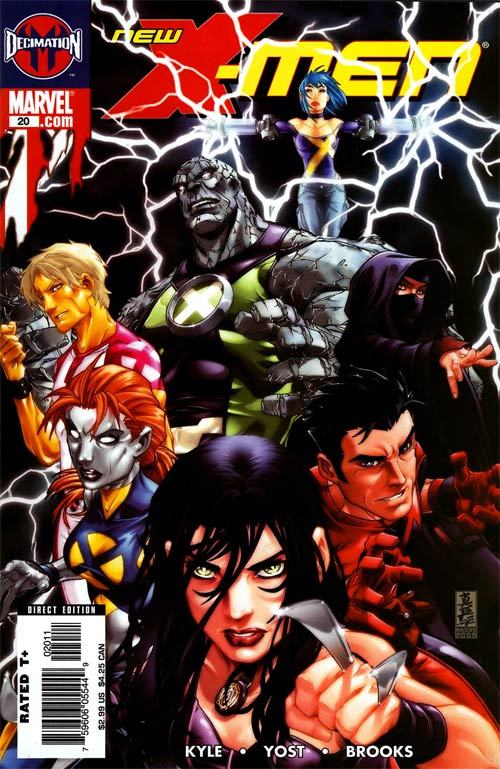
After the break, Christopher Yost and Craig Kyle take over and everything flips. In the wake of House of M, New X-Men becomes super-serious, man, and extremely violent, which is most apparent as X-23 joins the cast. The Reverend Stryker-led Purifers become the new antagonists and the body count rises. The writing is fine, but the 180-degree shift in tone made it really difficult for me to follow, especially as I had spent the previous 19 issues bonding with these kids. Yost and Kyle were demonstrating that the kids were forced to grow up, which I can understand on an intellectual level, but on a more emotional level, I just wasn’t into seeing teenagers straight-up murdered. After two arcs, I stopped reading the book altogether.
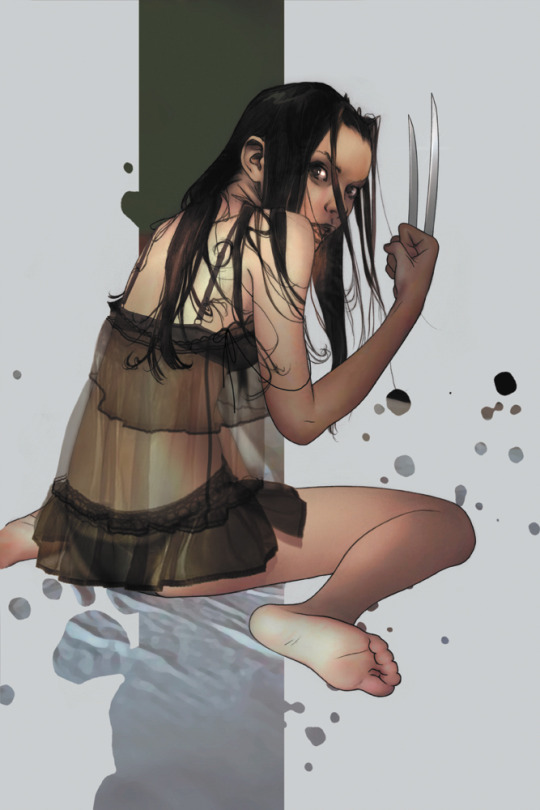
Around this same period, Marvel also published NYX, a 7-issue mini-series written by Joe Quesada (of all people). Basically, Quesada applies the mutant metaphor to gutter punks, which seems both obvious and perhaps a bit too on-the-nose, although the series is enjoyable enough. There’s some crazy shit in here though, which shouldn’t be surprising given that Quesada was also the one who had the idea of retconning Peter Parker and Mary Jane Watson’s marriage by having Spider-Man sell his soul to the devil. I didn’t realize it until later, but NYX was actually the first appearance of X-23 in Marvel comics. Here, she’s mute and enigmatic and working as a prostitute whose specialty seems to be clients who like to be cut (I told you this shit was nuts). The best part of the series, though, is beautiful Joshua Middleton art.

One final mini-series that I read was X-23: Innocence Lost, which tells the titular character’s origin story. It’s a fairly workmanlike run-of-the-mill origin story (Bloodshot, for instance, has an almost identical origin, as have countless other characters in TV and media), but there’s a few interesting wrinkles. It was interesting that X-23′s “mother” was a fellow scientist essentially forced into the role, but even more important was that she developed a kind of maternal bond with Laura, but never became thoroughly redeemed. Admittedly, she doesn’t want to see her daughter become a mindless, amoral killing machine, but ultimately, her motives are mostly selfish. Other than that, this series can be skipped by all but die-hard X-23 fans.
More than anything, all three of these mini-series (and X-23: Target X, another mini that takes place between Innocence Lost and NYX) show the difference between Marvel’s mentality regarding its X-Men titles now and ten years ago. Currently, Marvel is publishing 10 X-titles, but 4(!!!) of them are either Deadpool or spin-offs of Deadpool. More than anything, this shows that the character is so popular that he can basically have his own group of titles,* which probably shouldn’t fall under the X-Men umbrella. Four of the remaining titles feature core X-members with two being “time displaced” (All-New X-Men) or “alternate universe” (X-Men ‘92). Then, of course there’s two Wolverine titles. Admittedly, I haven’t read any of the All-New All-Different titles yet, but at least from the outside there isn’t much to distinguish the titles other than the characters in each.
In contrast, ten years ago Marvel published a core title (Uncanny X-Men), a prestige title for premier writers and artists (Astonishing X-Men), a title featuring the younger X-Men (New X-Men), a group of detectives who operated in the former mutant neighborhood of New York (X-Factor), and a few years later you had a black ops/assassin squad (X-Force) in addition to solo title for Wolverine and Cable, and a slew of various mini-series. Back then, it felt as if editorial was interested in exploring the various “mutant” nooks and crannies of the Marvel Universe, whereas now it feels as if they don’t want to chance anything other than the proven sellers. This is one of the major reasons (well that and too much Wolverine) that the current line-up of X-Men titles just don’t interest me.
Regardless, if you have a Marvel Unlimited subscription or you have a disposable income and live close to a comic book store with a good collection of back-issues, you could do a lot worse than check out of some of these comics.
*-He’s also a cast member in a couple Avengers comics. In other words, Deadpool has replaced Wolverine as Marvel’s most oversaturated character.
#new x-men#new mutants#nyx#hellions#x-23#laura kinney#prodigy#hellion#elixir#wind rider#wallflower#dani moonstar#rahne sinclair#cyclops#emma frost#joe quesada#gutter punk
8 notes
·
View notes
Text
Review: Conan/Red Sonja
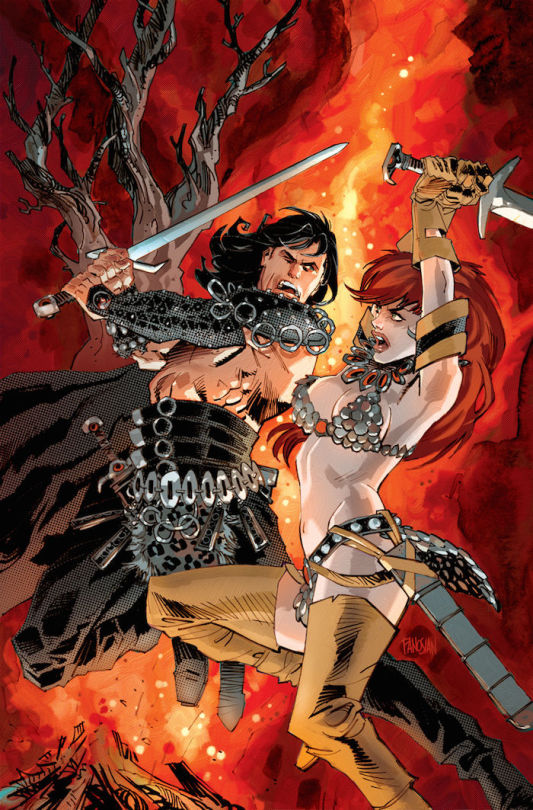
Conan/Red Sonja by Gail Simone and Jim Zub (writers), Dan Panosian and Randy Green (artists), Rick Ketchum (inker), Dave Stewart (colorist), Richard Starkings & Comicraft (letterers)
Admission: I’ve never read a single Conan story, either from the comics or even any of Robert E. Howard’s original stories.
Even Worse Admission: I haven’t seen any of the films either (well, I did catch the last 10 minutes or so of both Conan the Destroyer and the more recent Conan the Barbarian on Cinemax once).
Given all that, I’m obviously not in a position to talk about whether the Dark Horse/Dynamite Entertainment crossover Conan/Red Sonja manages to tell a story while simultaneously remaining true to the characters and respective worlds of each (something which many interfranchise crossovers struggle with). All I am able to do is to judge the story on its own merits, and from that perspective, the story is entertaining and enjoyable.
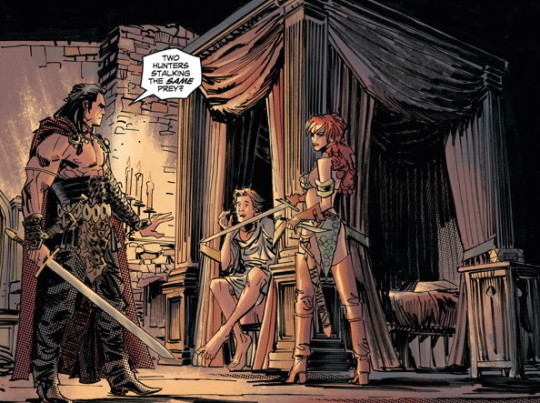
The four-issue miniseries tells the story of three separate meetings between the icons, with many years often taking place between issues. Essentially, there’s a plot by Thoth-Amon to rule the world using a deadly plague in the form of a plant called Bloodroot, but, more than anything, the plot is an exercise for these two characters to meet one another while also including a few Easter eggs, such as the presence of Belit in the second issue. Again, I can’t speak for someone who is significantly more invested in these characters, but, I was charmed by the interactions between Sonja and Conan, and I liked the way that the loose story structure was able to vary them.
From what little I do know of the protagonists, the writers seem to have done an excellent job of capturing their voices, and, more importantly, their spirit. Conan and Red Sonja both live up to their names (”the Barbarian” and “the She-Devil,” respectively). These are individuals who truly refuse to conform to anyone or anything and have no respect for any institution that lacks the will to back up its authority, as their contempt for the royalty in the first issue wonderfully illustrates.

That said, I also appreciate that Jim Zub and Gail Simone do present them as being heroic. Admittedly, while some of their actions are probably the result of their restless and adventurous spirit, as in the second issue both ignore the voices of their respective partners who tell them that the Bloodroot isn’t their problem to instead attempt to destroy it. And while, more often than not, their solution to problems simply consists of “cut it down with a sword,” I do like that they both show intelligence and make use of tactics.
Finally, I love the way that the relationship between the two develops. It begins in distrust as they are both hired to retrieve the same object, but it quickly turns to respect after a brief battle, and a bond forms over their shared status as perceived savages (he’s a Cimmerian, she’s a Hyrcanian). One aspect that I really appreciated was that the writers didn’t fall into the easy trap of having the characters develop romantic feelings for one another (they do have a quick moment of passion, but it’s presented as stemming more from lust rather than love). Instead, they share more if a buddy-type relationship, which I always appreciate.*
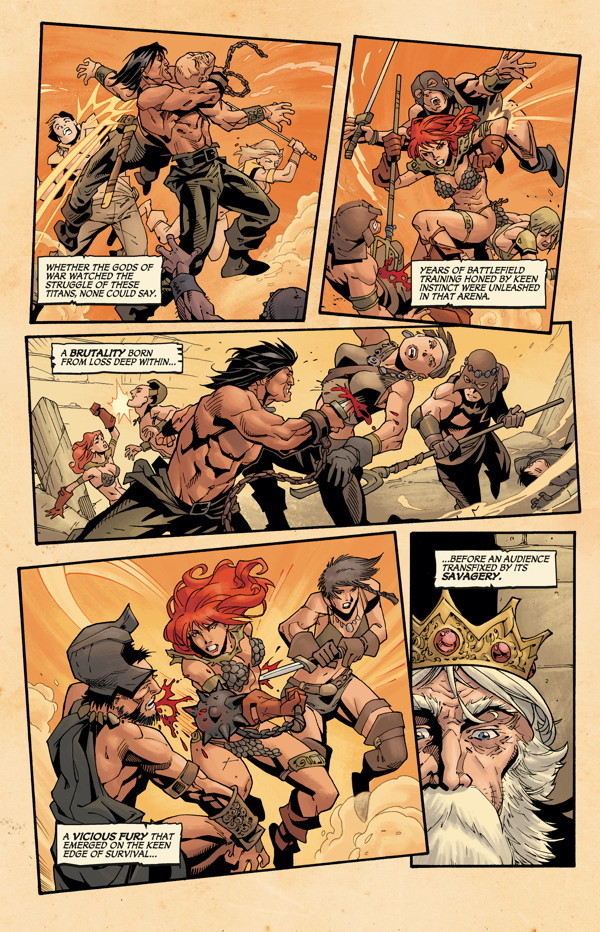
Dan Panosian and Randy Green split the art duties for this mini-series with Panosian drawing the first two issues and Green finishing the second half. Stylistically, they’re quite similar with both drawing in a cartoony, kinetic style that looks rather sloppy at first glance but is actually quite refined. Both are a good fit for the material, although I prefer Panosian as his work tends to be slightly more crisp, especially in the background details. Nevertheless, the art looks pretty good throughout, and colorist Dave Stewart’s presence throughout the series is a major asset, as he gives the work of both artists a fairly uniform appearance and uses a color palette that a perfect fit for fantasy-based story.
Altogether, I really enjoyed this comic, even though it was my first exposure to both characters. Granted, there are elements which are a bit rough, such as the third-person voice-over narrative, but I’m willing to overlook some of those weaknesses as they’re characteristic of the genre. More than anything else, Conan/Red Sonja is fun, and that is more than enough for me to recommend it.
*-It was a lot like the friendship between Captain America and Black Widow in Captain America: The Winter Soldier, which was one of that film’s greatest strengths for me.
#conan#red sonja#gail simone#jim zub#dan panosian#randy green#dynamite entertainment#dynamite comics#dark horse comics#comic reviews#comics
0 notes